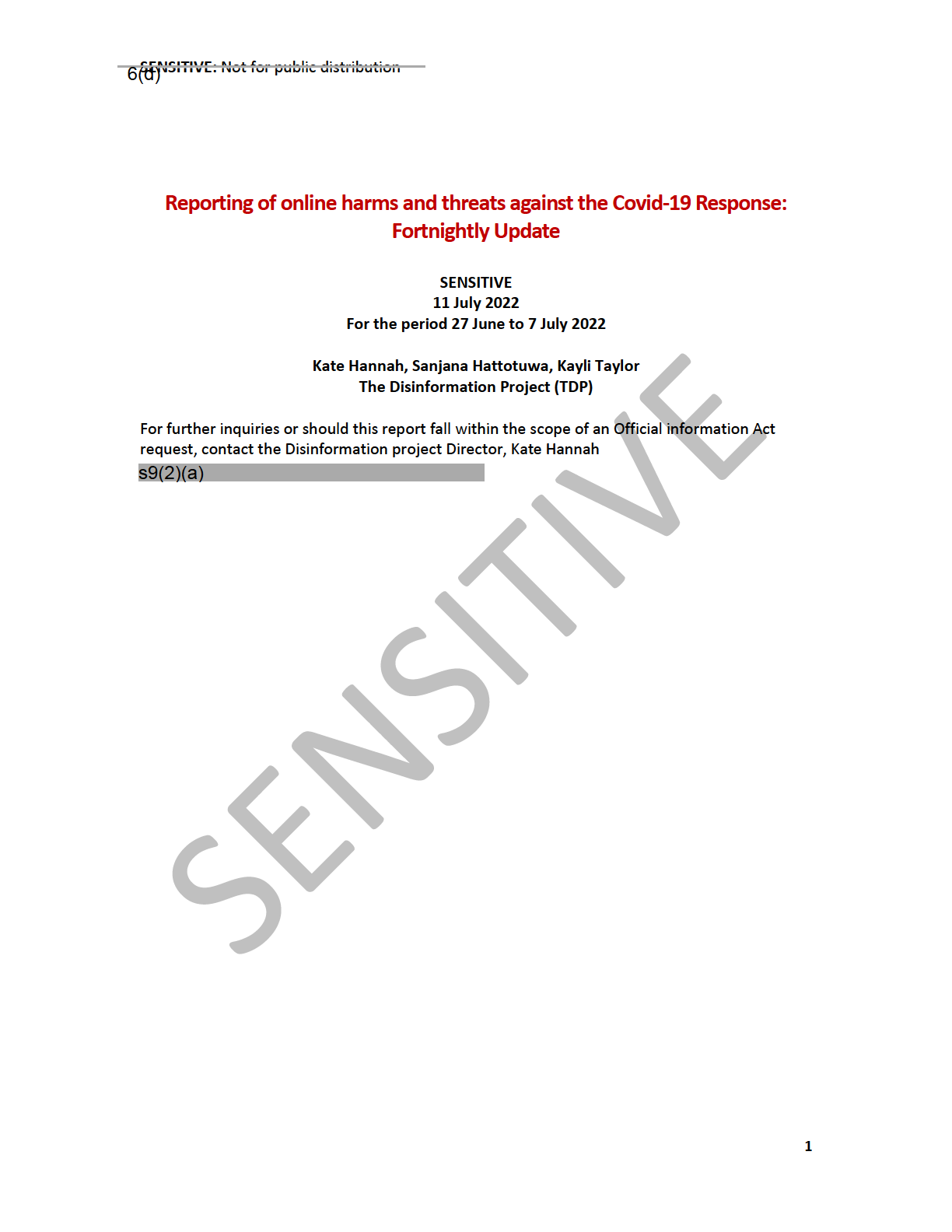
Under the Official Information Act
Released
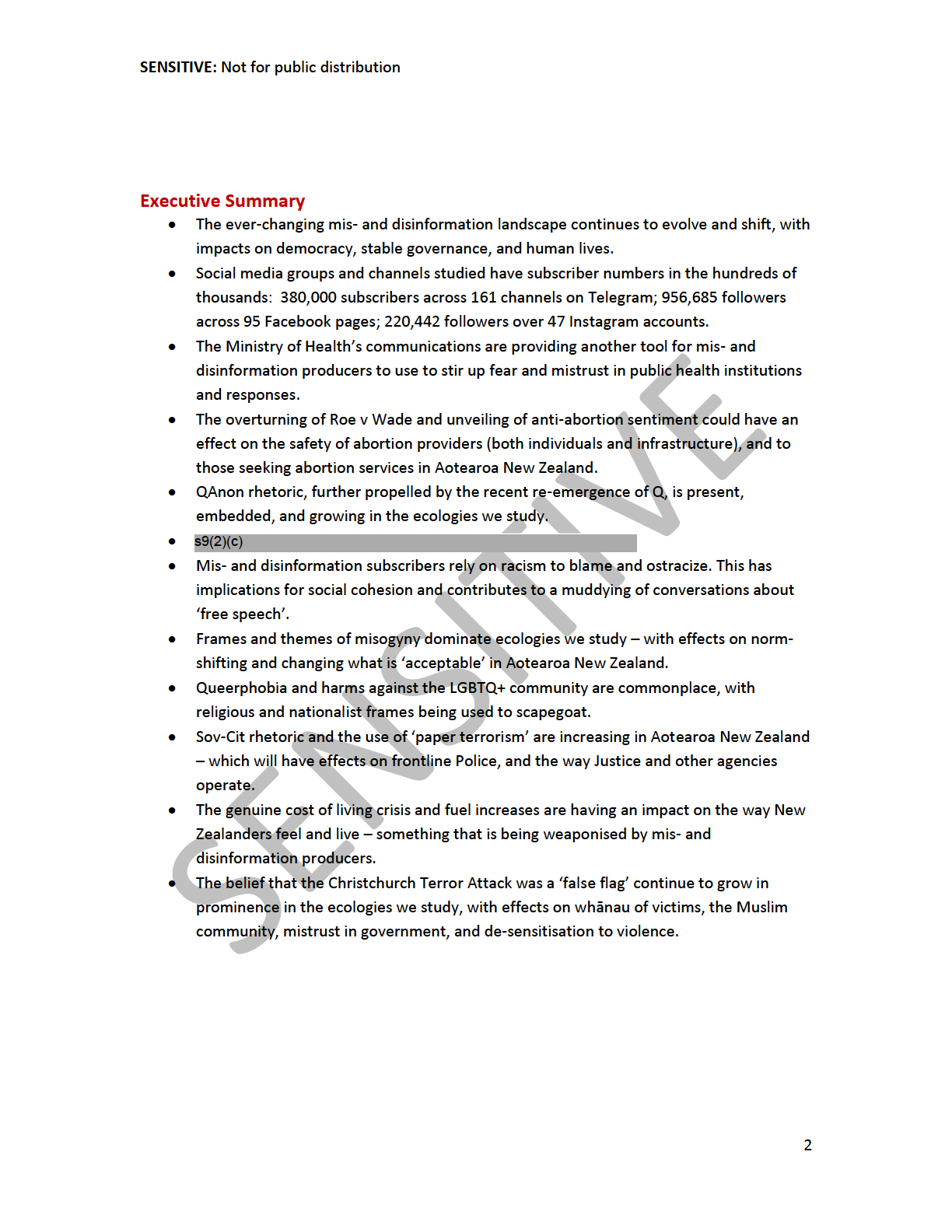
Act
Information
Official
the
Under
Released
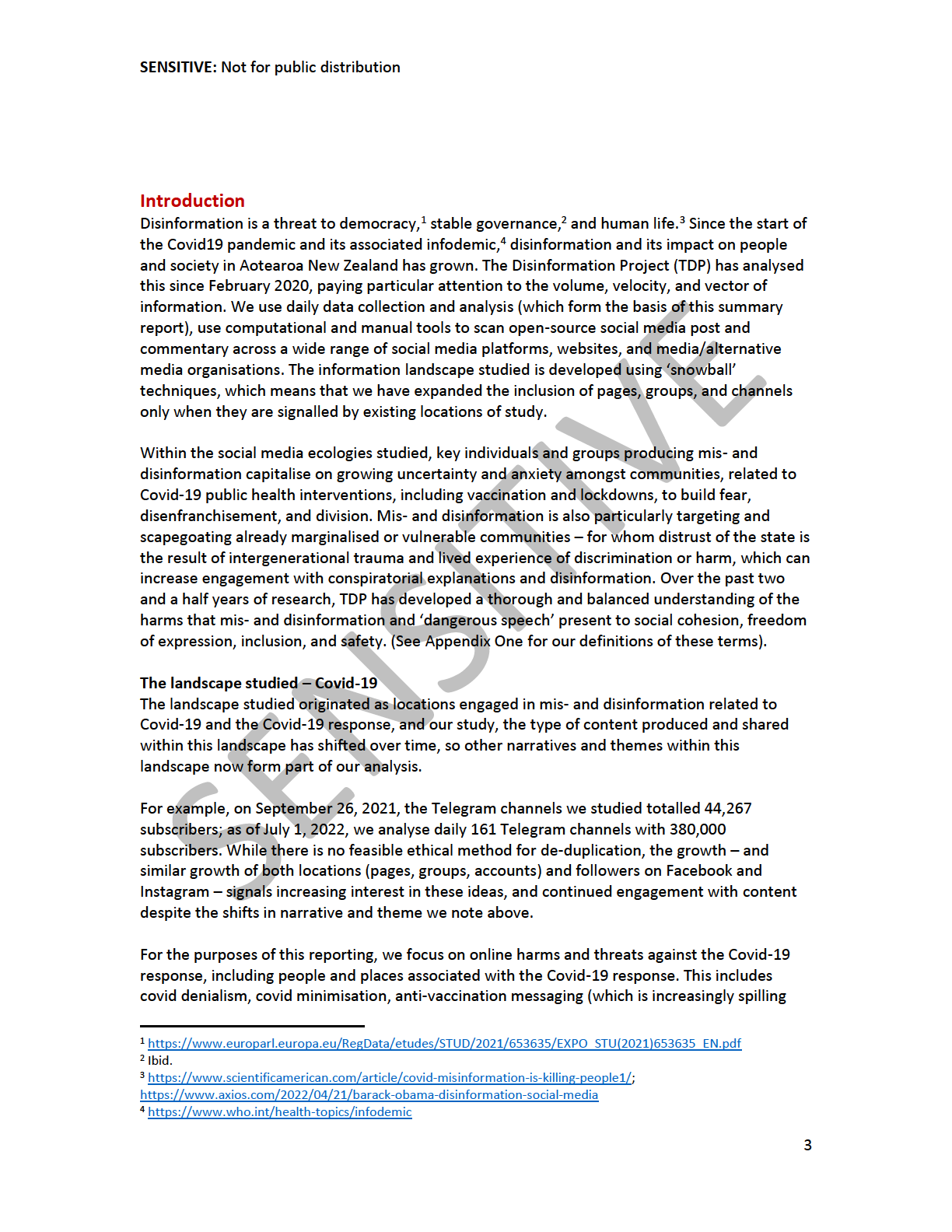
Act
Information
Official
the
Under
Released
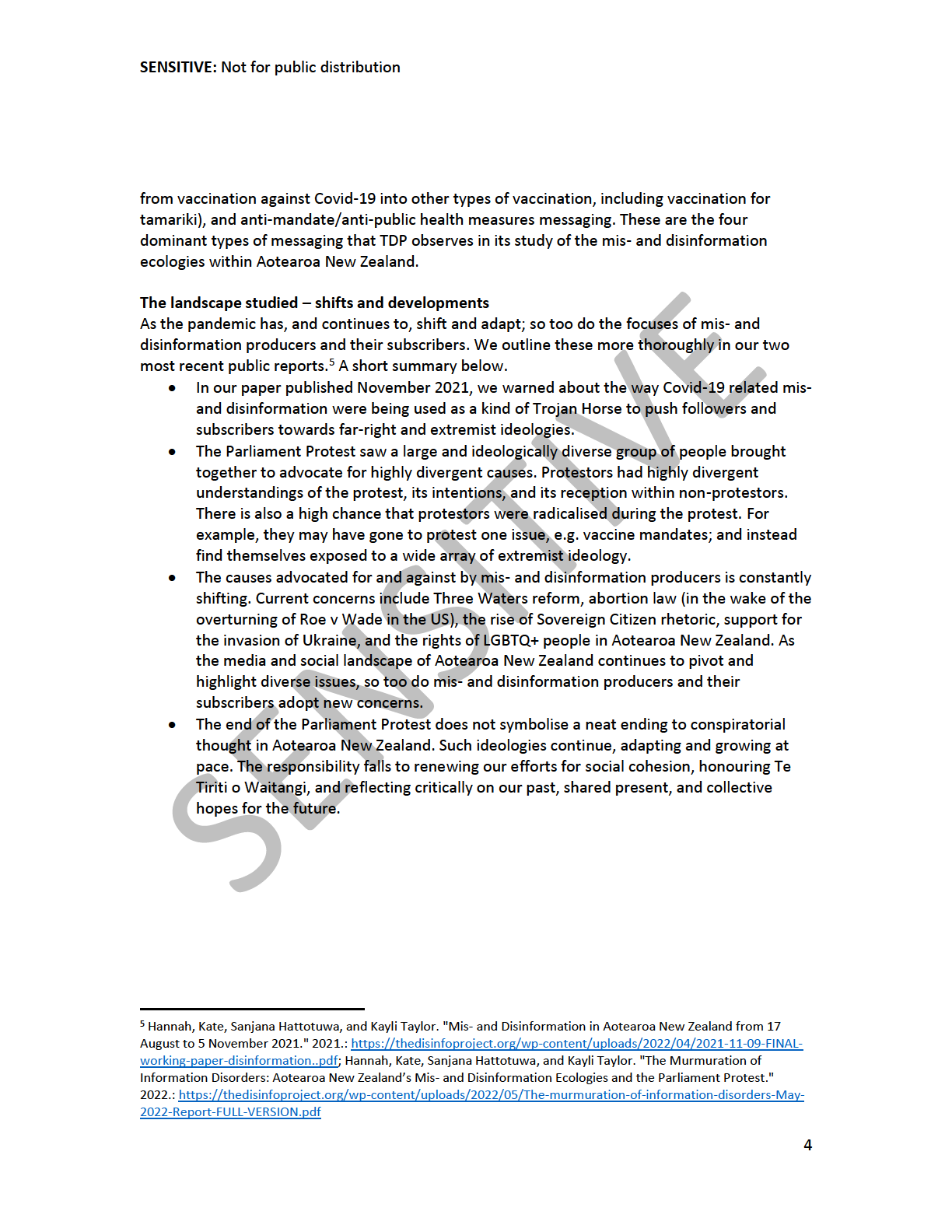
Act
Information
Official
the
Under
Released
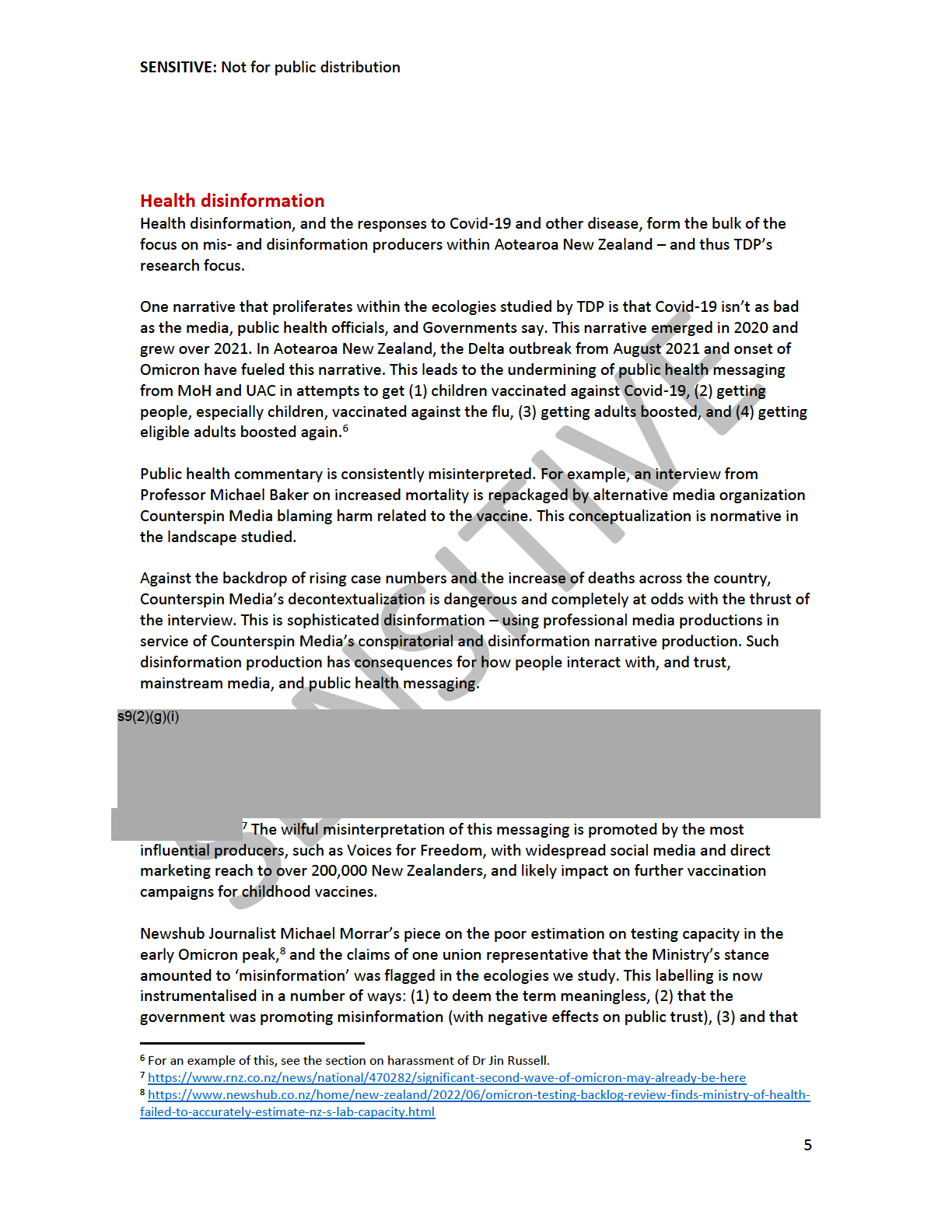
Act
Information
Official
the
Under
Released
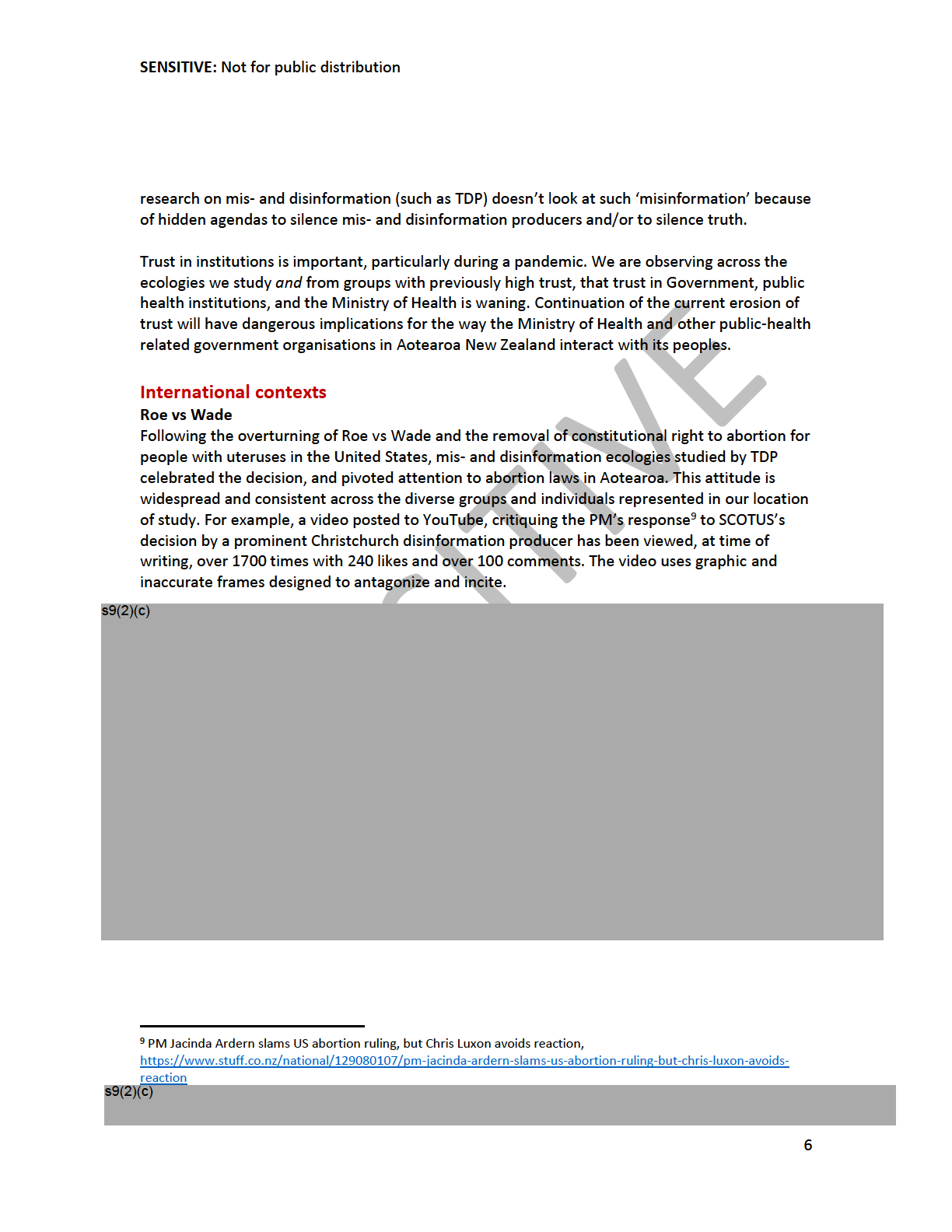
Act
Information
Official
the
Under
Released
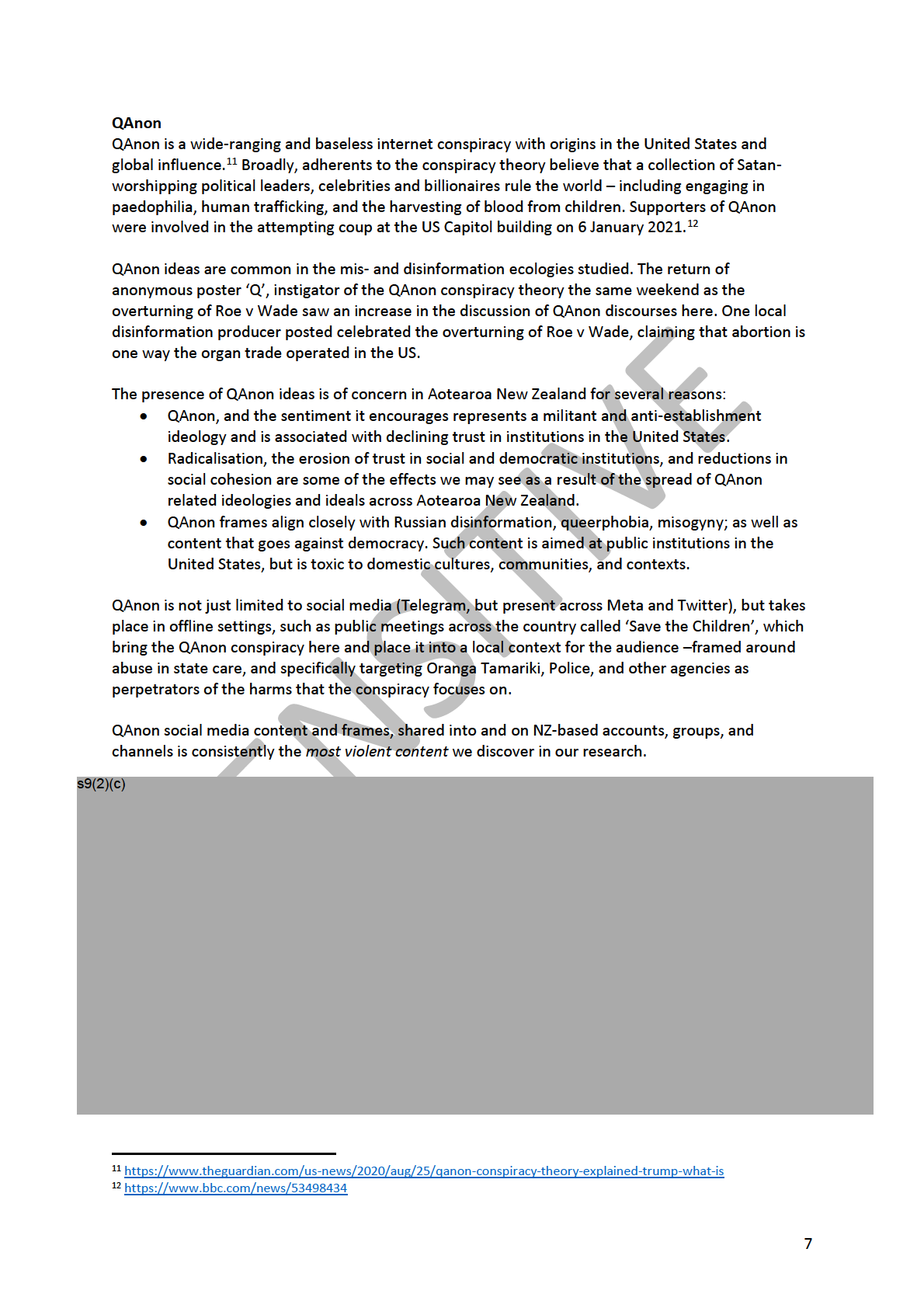
Act
Information
Official
the
Under
Released
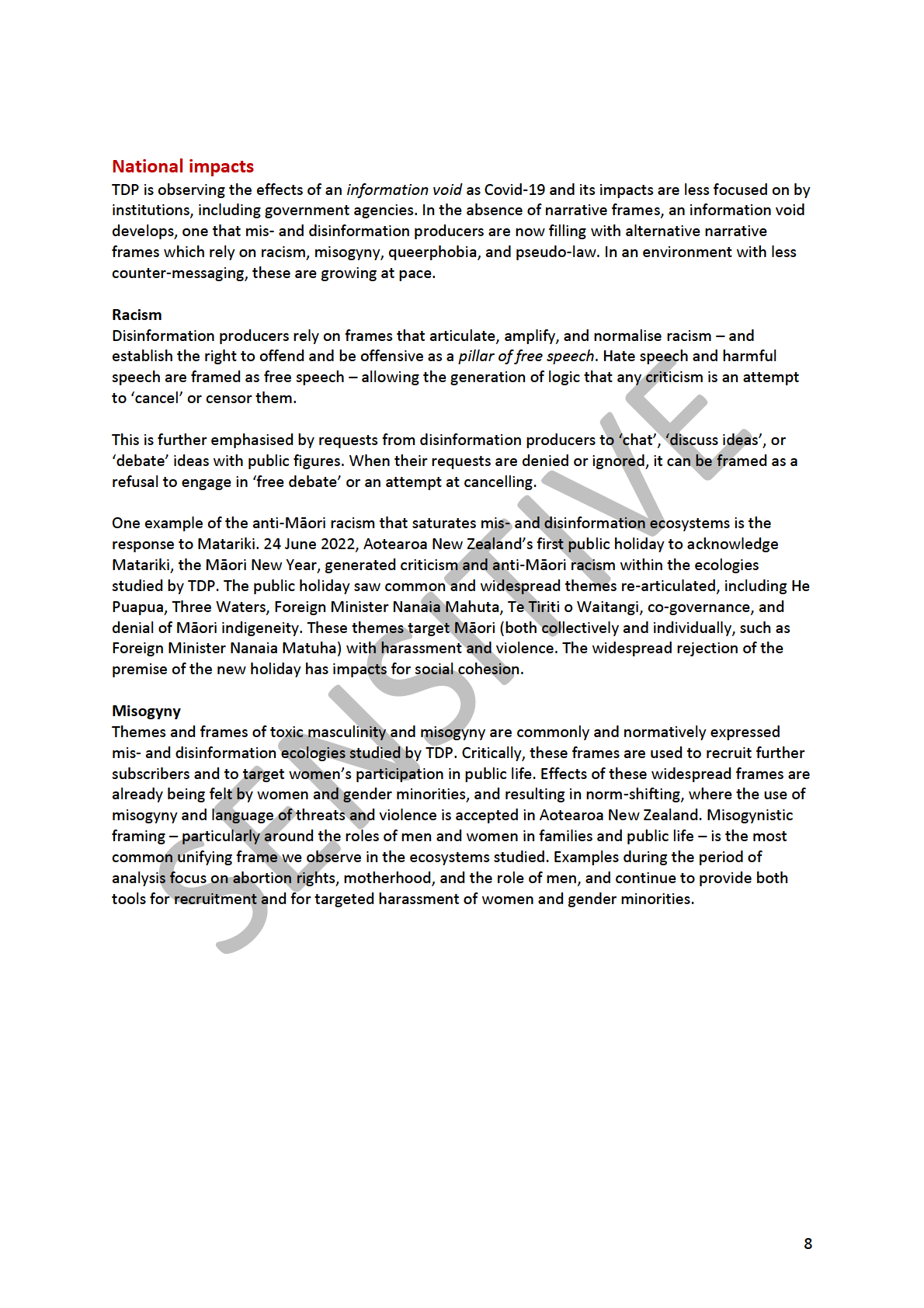
Act
Information
Official
the
Under
Released
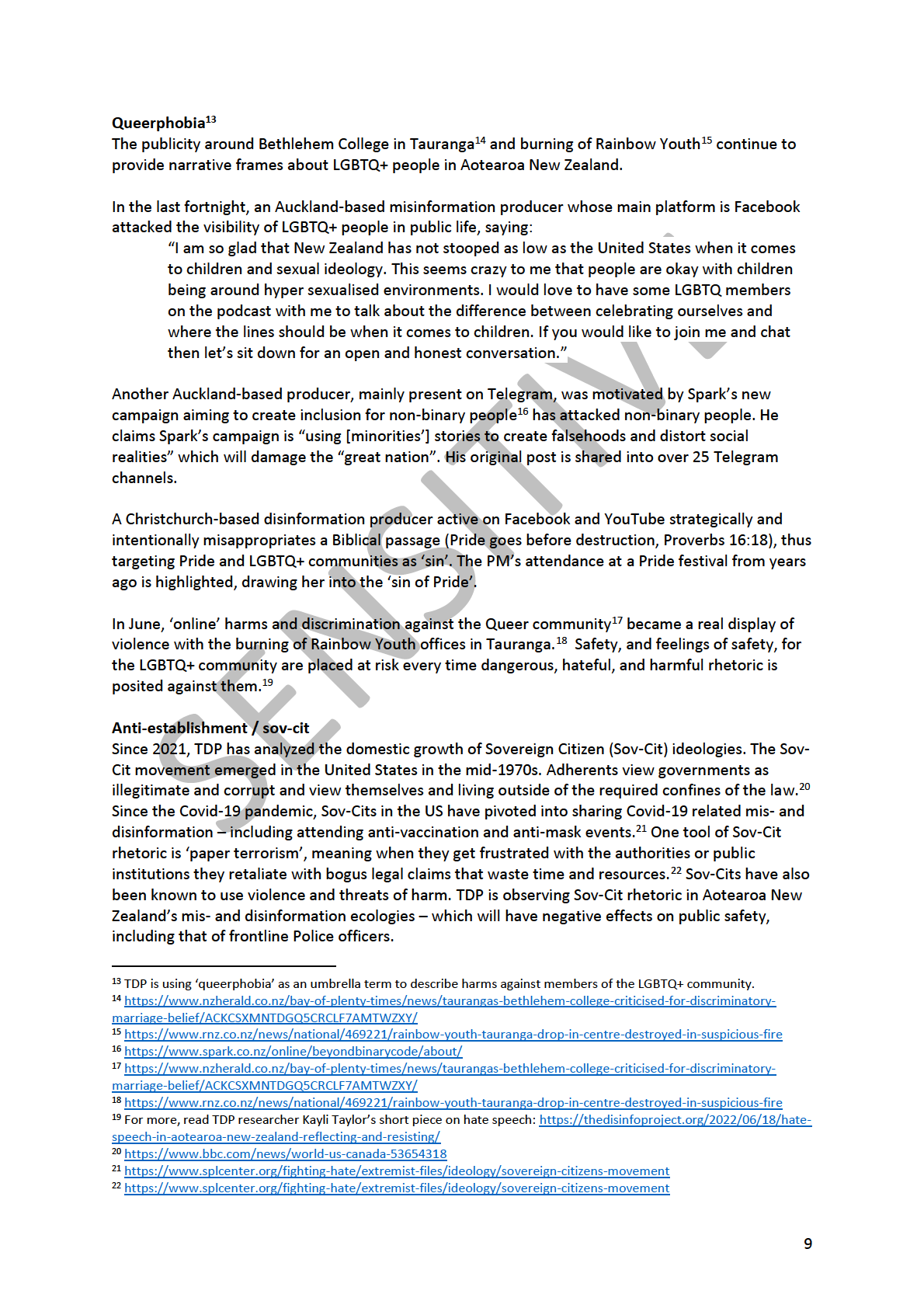
Act
Information
Official
the
Under
Released
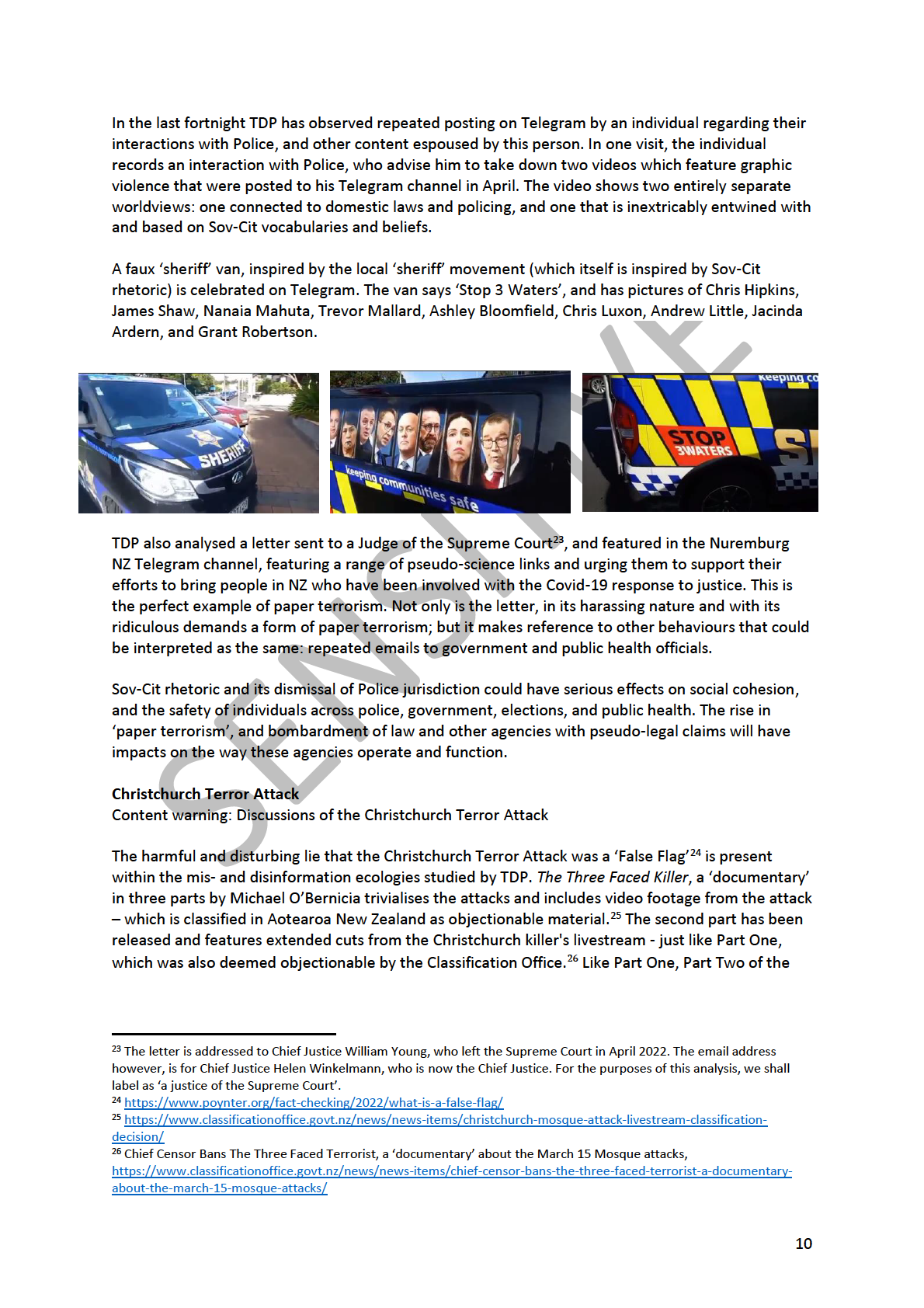
Act
Information
Official
the
Under
Released
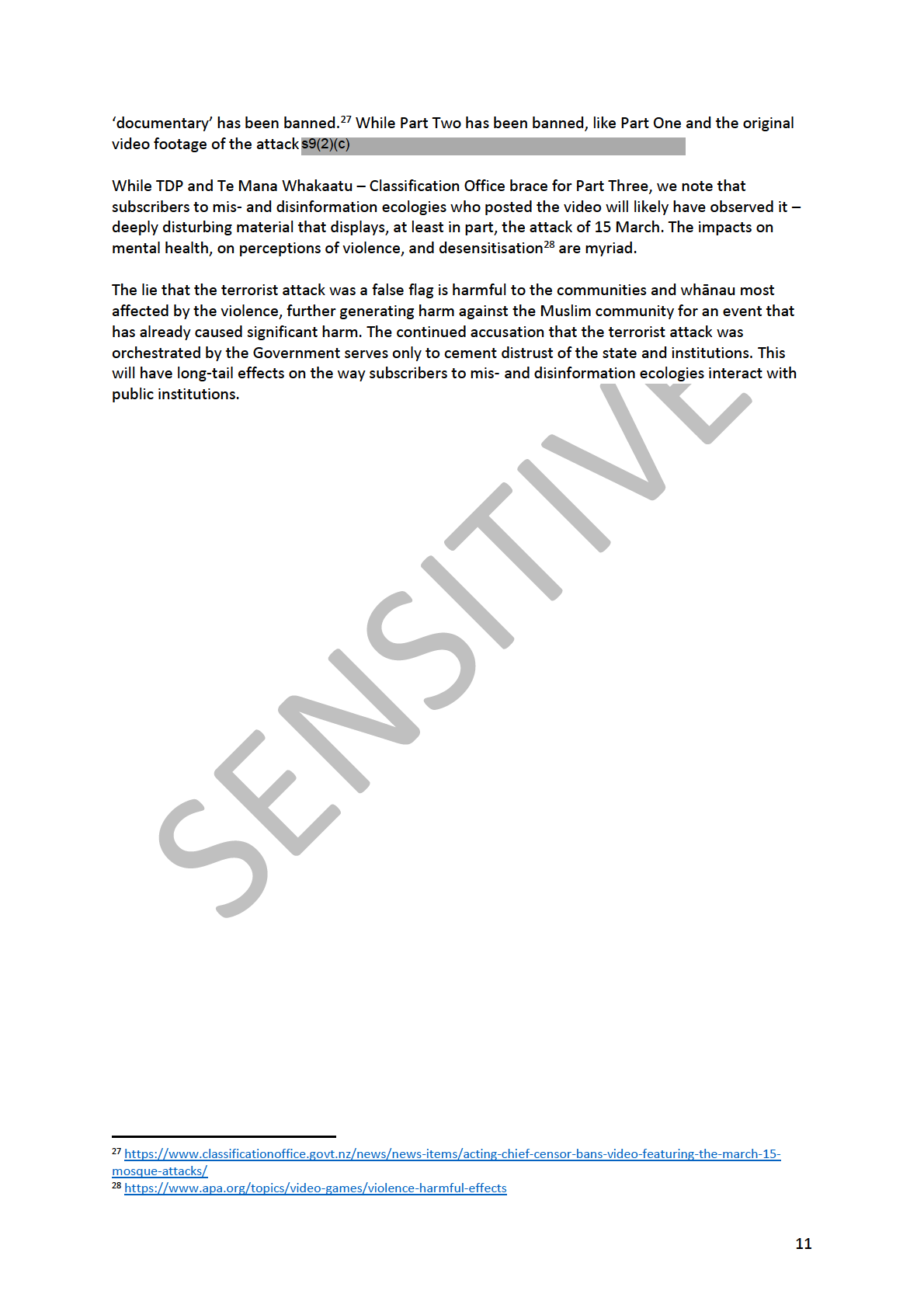
Act
Information
Official
the
Under
Released

Act
Information
Official
the
Under
Released
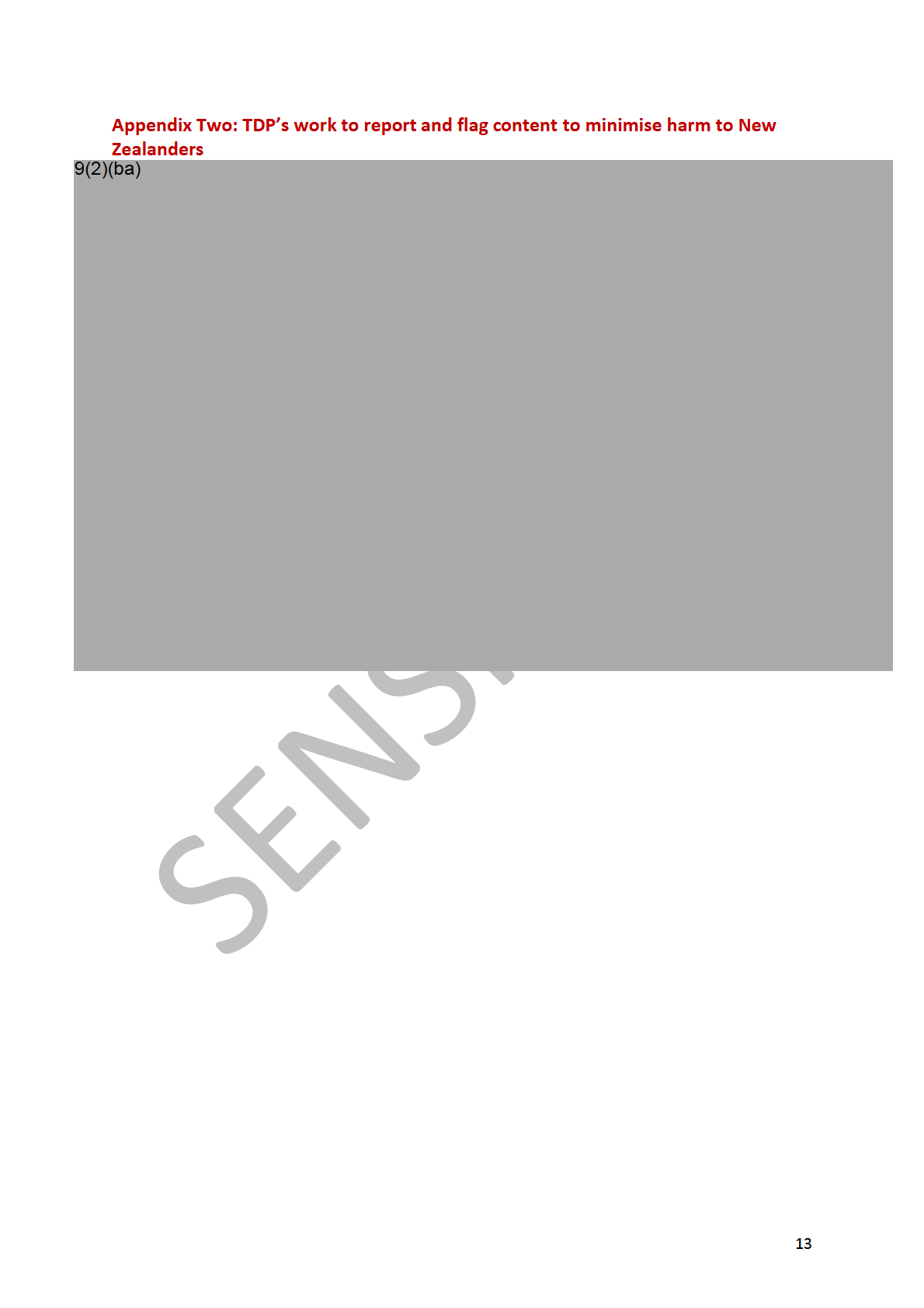
Act
Information
Official
the
Under
Released
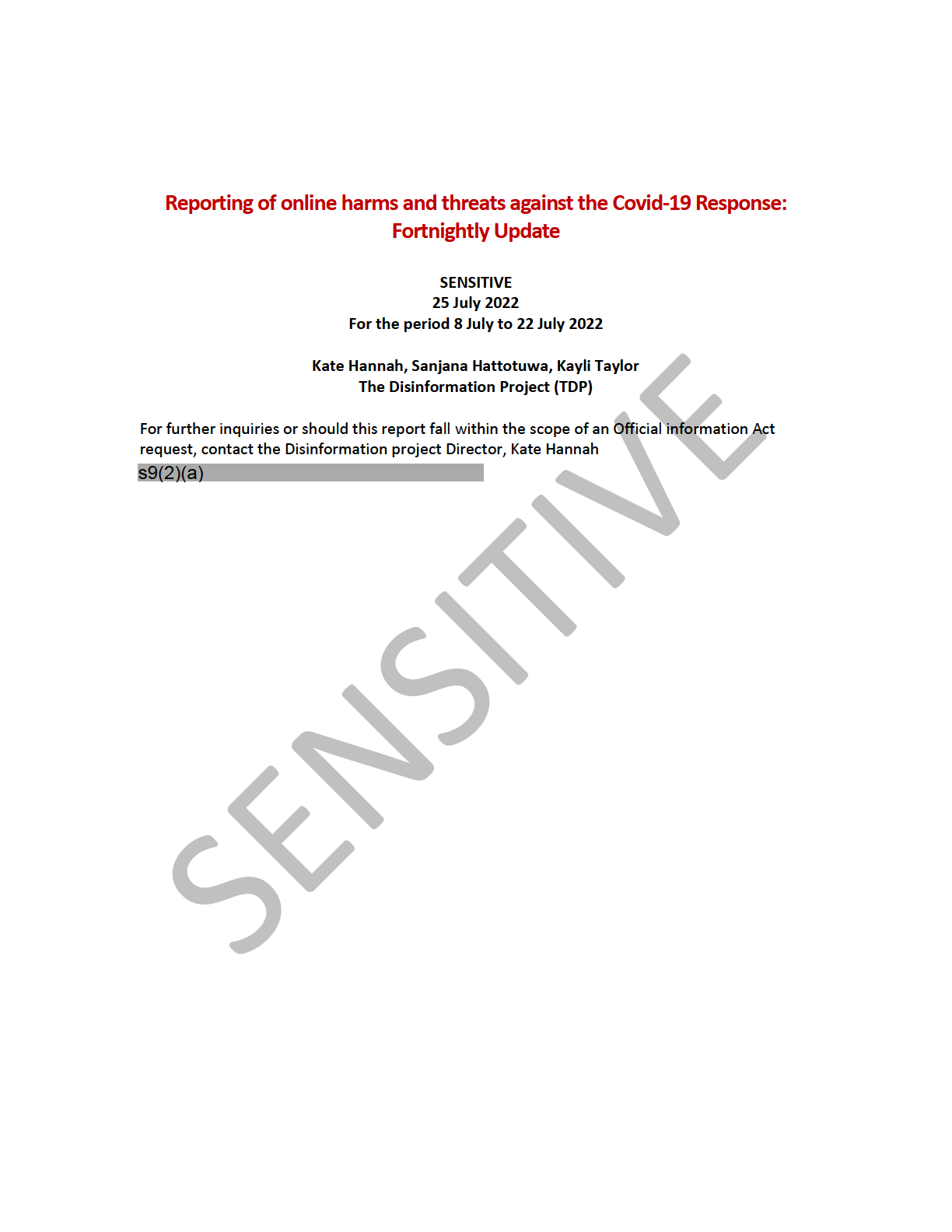
Act
Information
Official
the
Under
Released
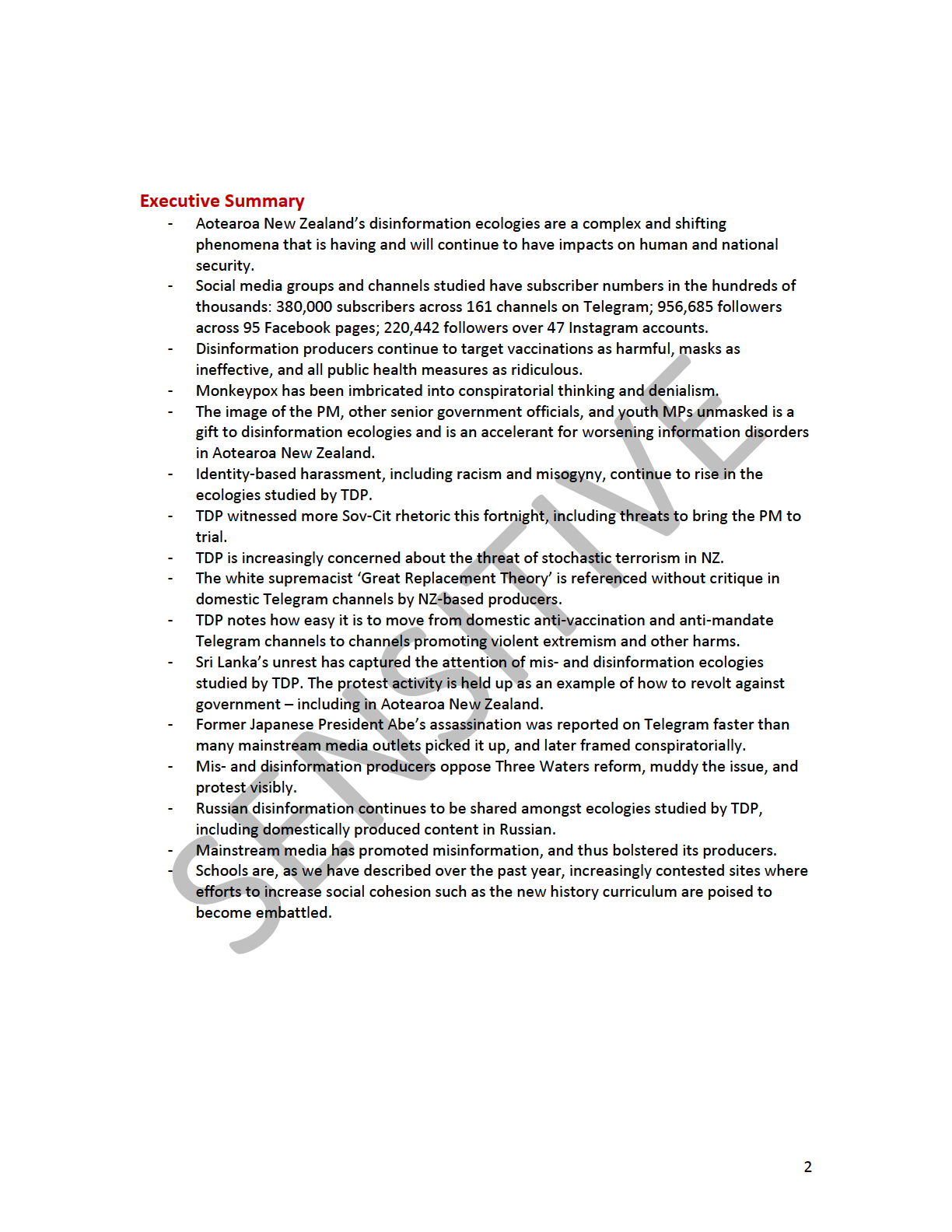
Act
Information
Official
the
Under
Released
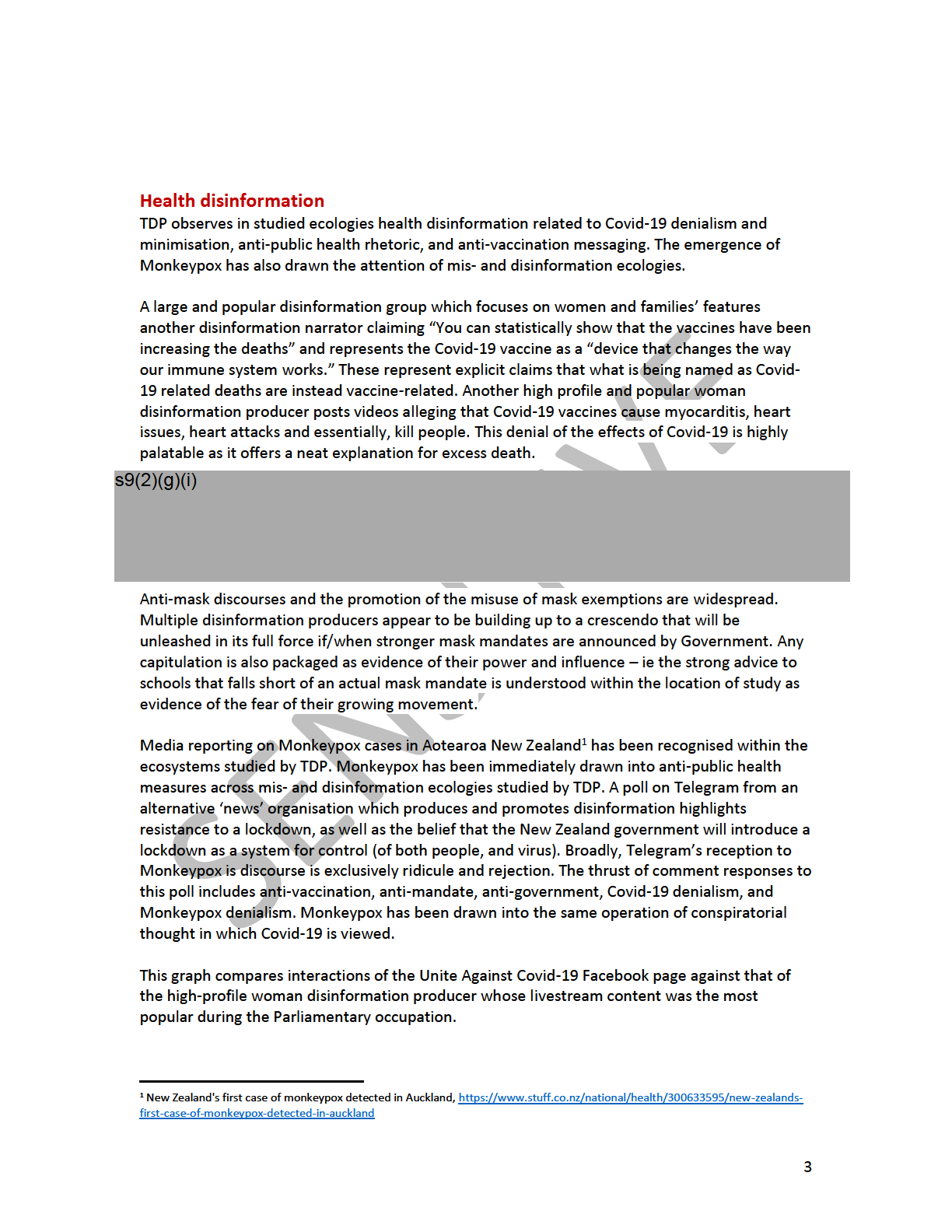
Act
Information
Official
the
Under
Released
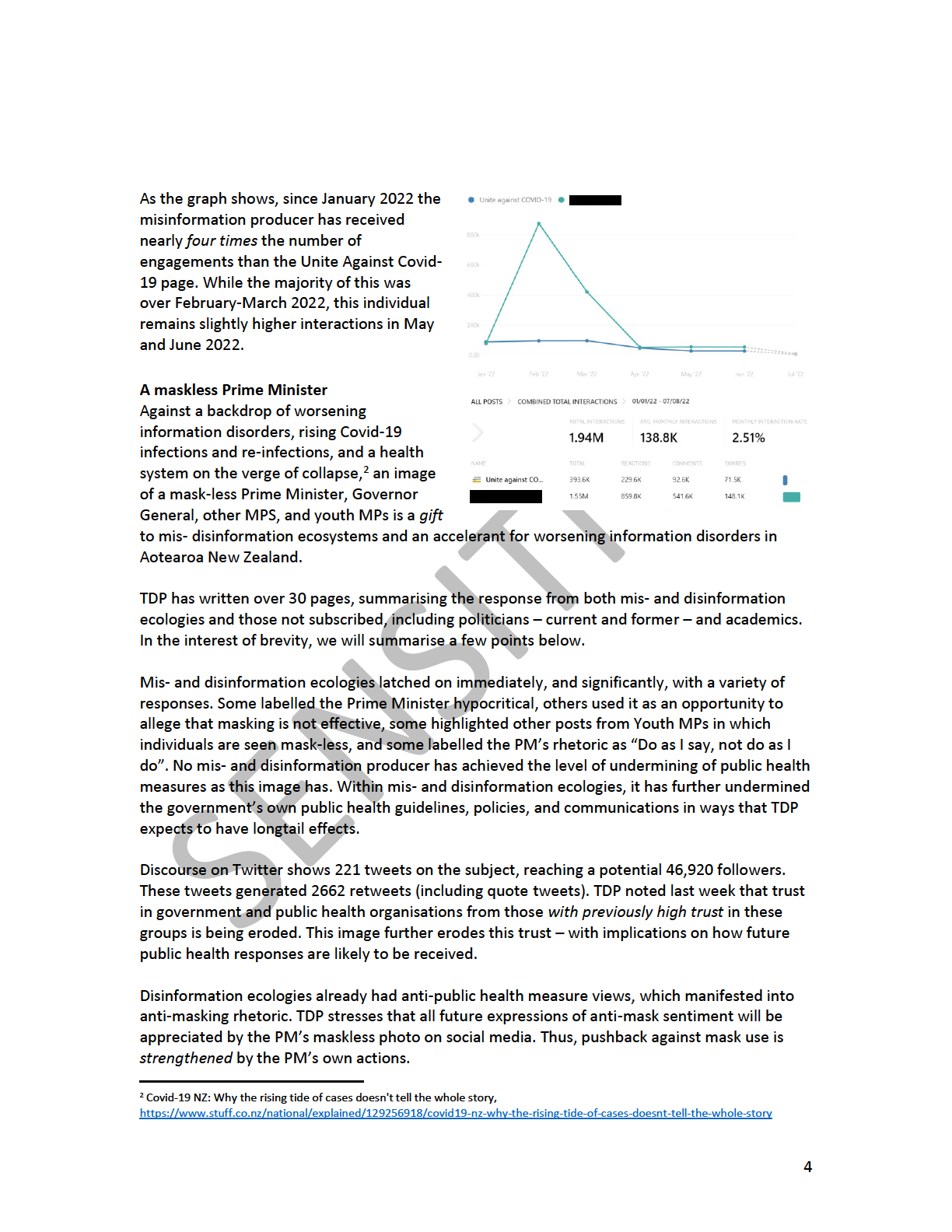
Act
Information
Official
the
Under
Released
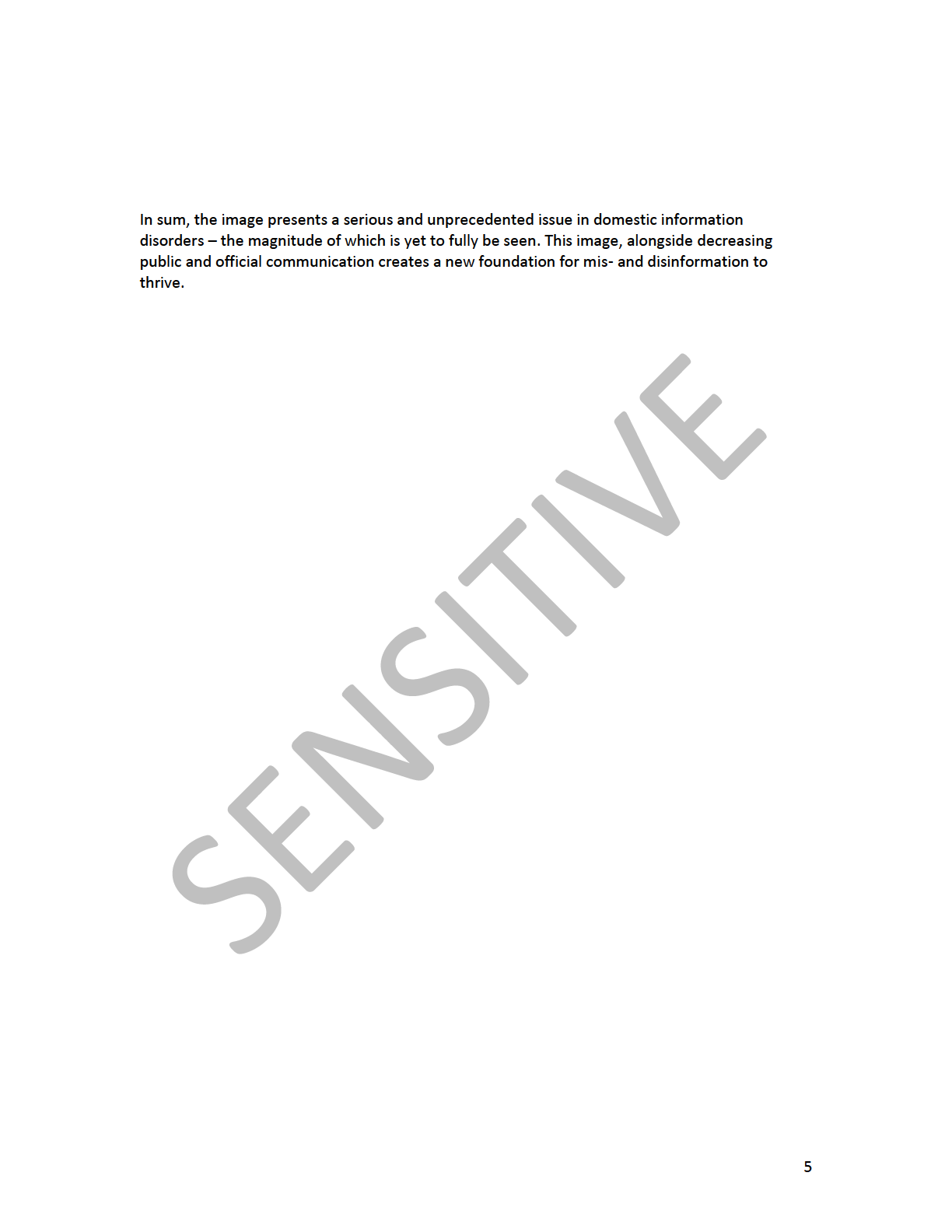
Act
Information
Official
the
Under
Released
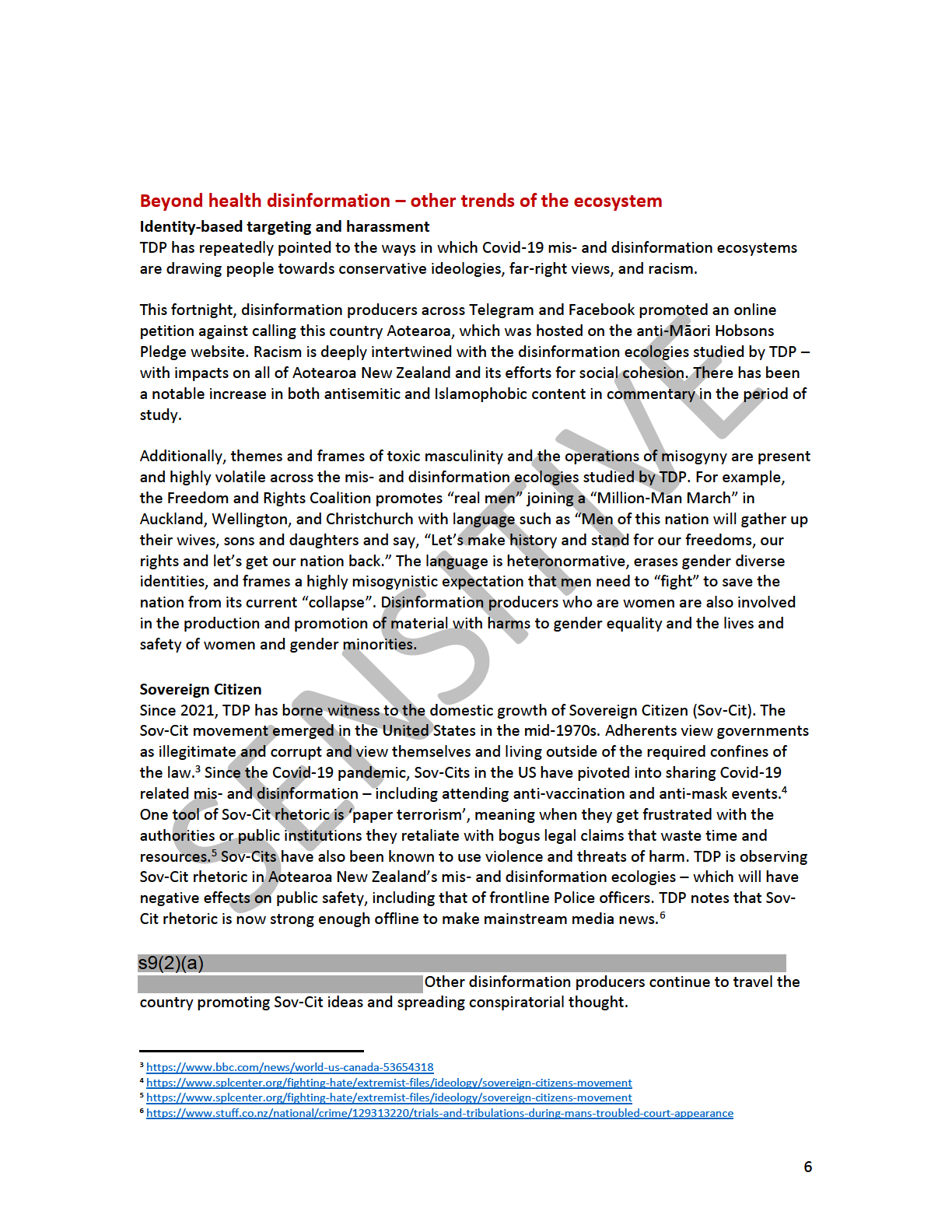
Act
Information
Official
the
Under
Released

Act
Information
Official
the
Under
Released
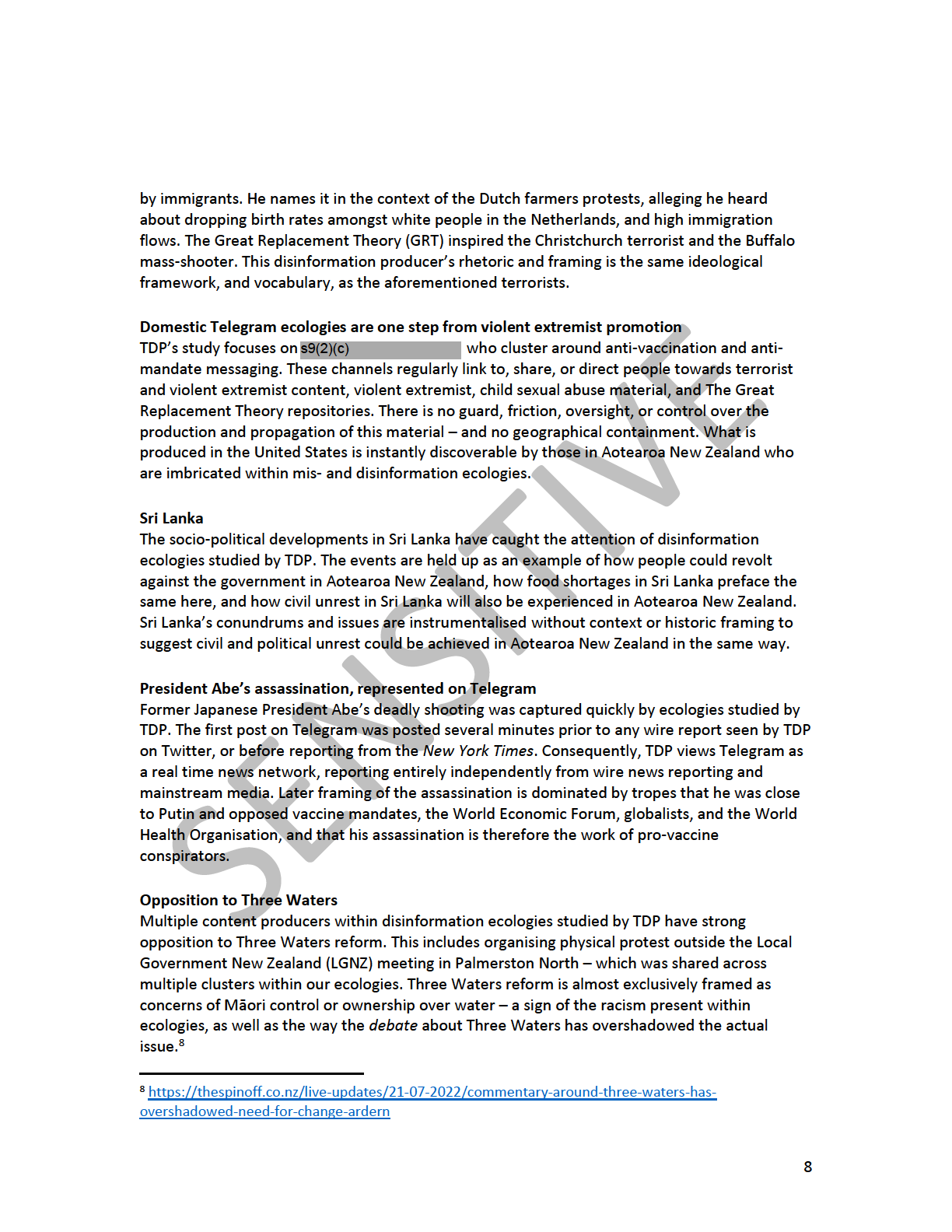
Act
Information
Official
the
Under
Released
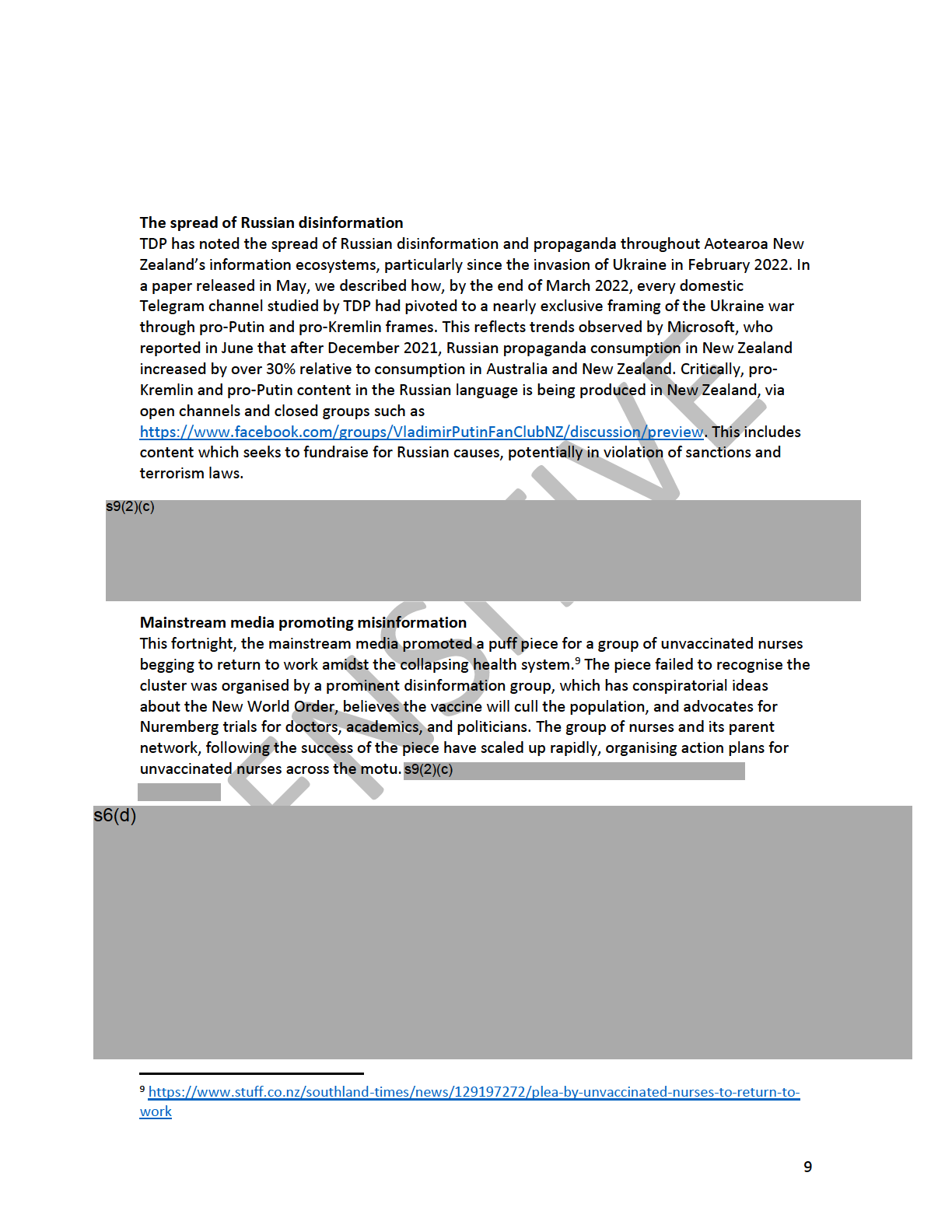
Act
Information
Official
the
Under
Released

Act
Information
Official
the
Under
Released
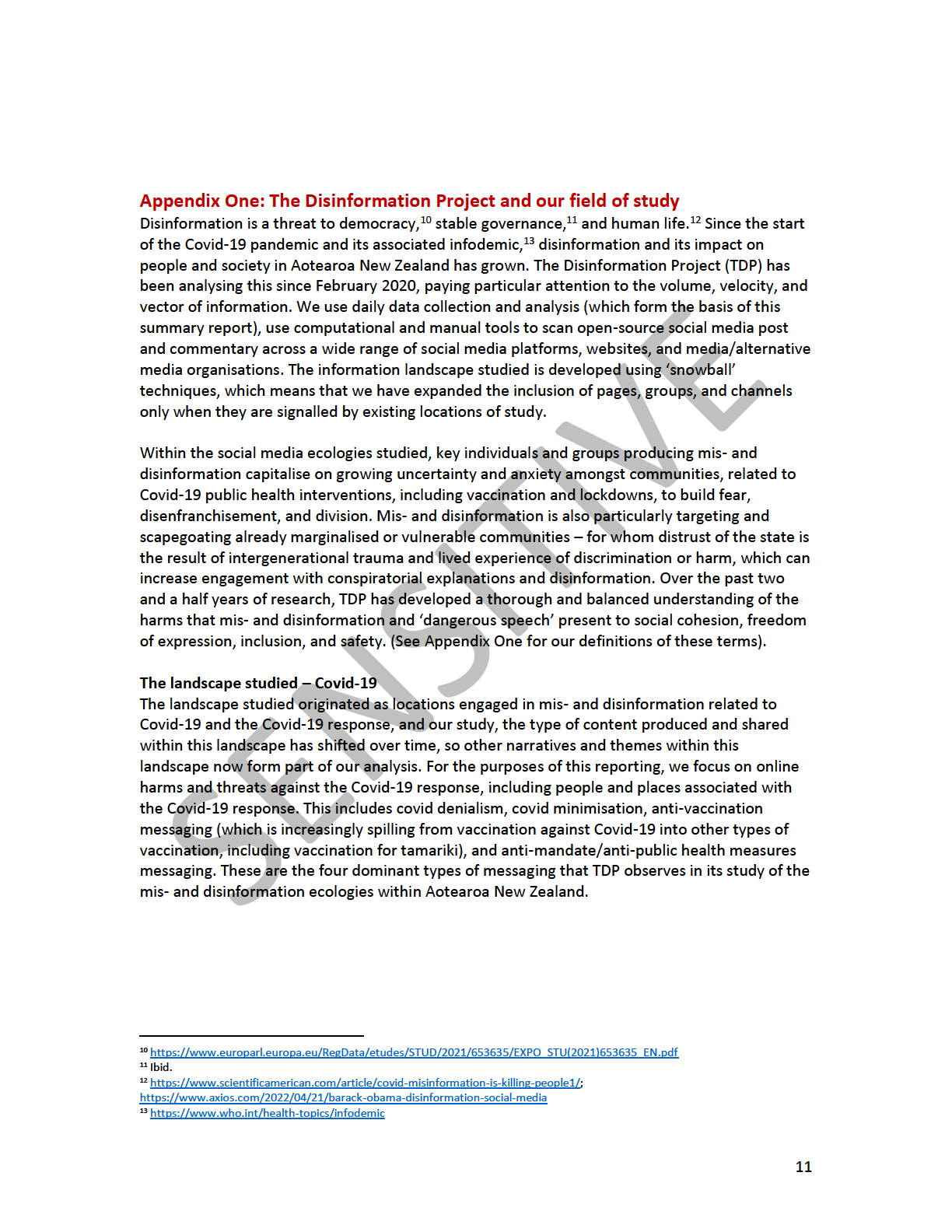
Act
Information
Official
the
Under
Released
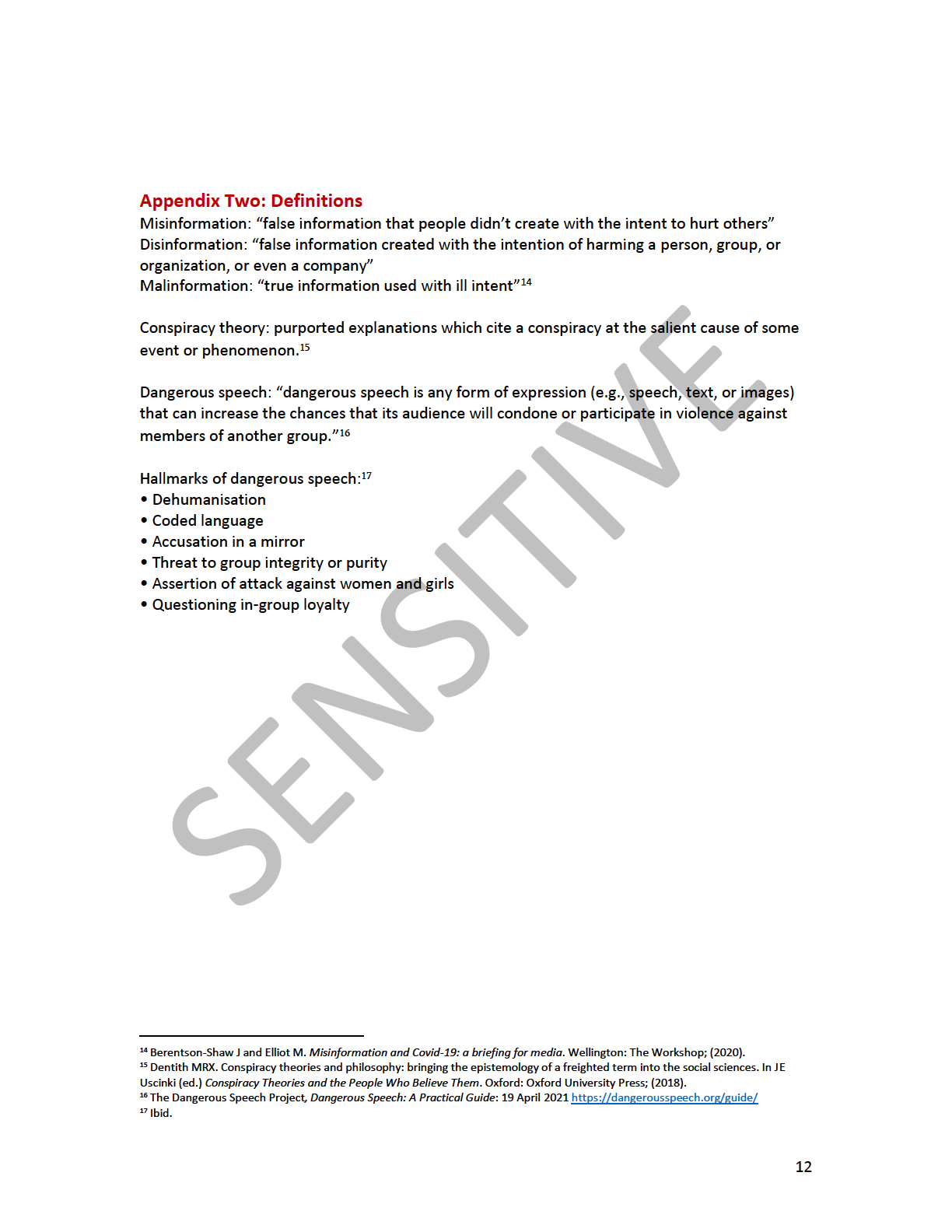
Act
Information
Official
the
Under
Released
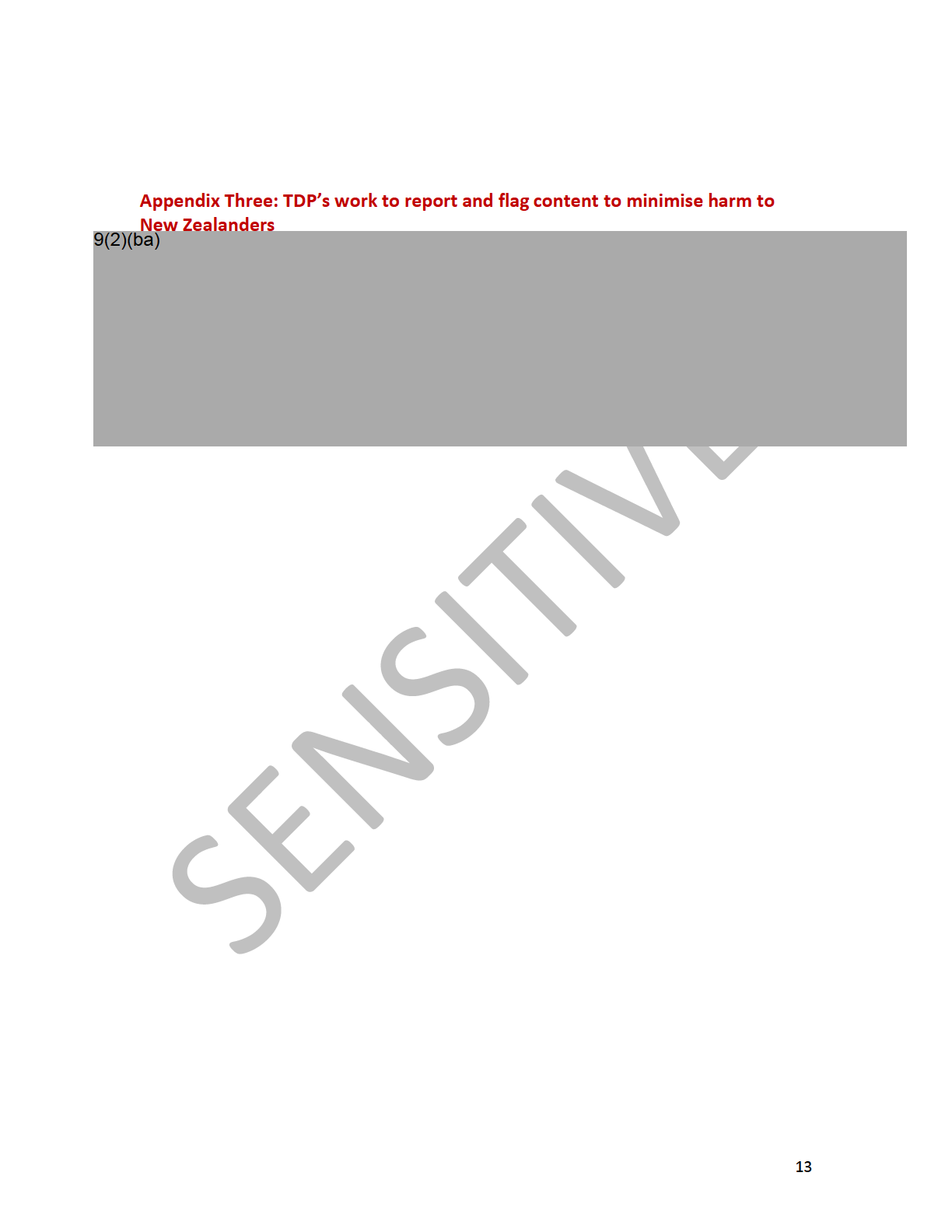
Act
Information
Official
the
Under
Released
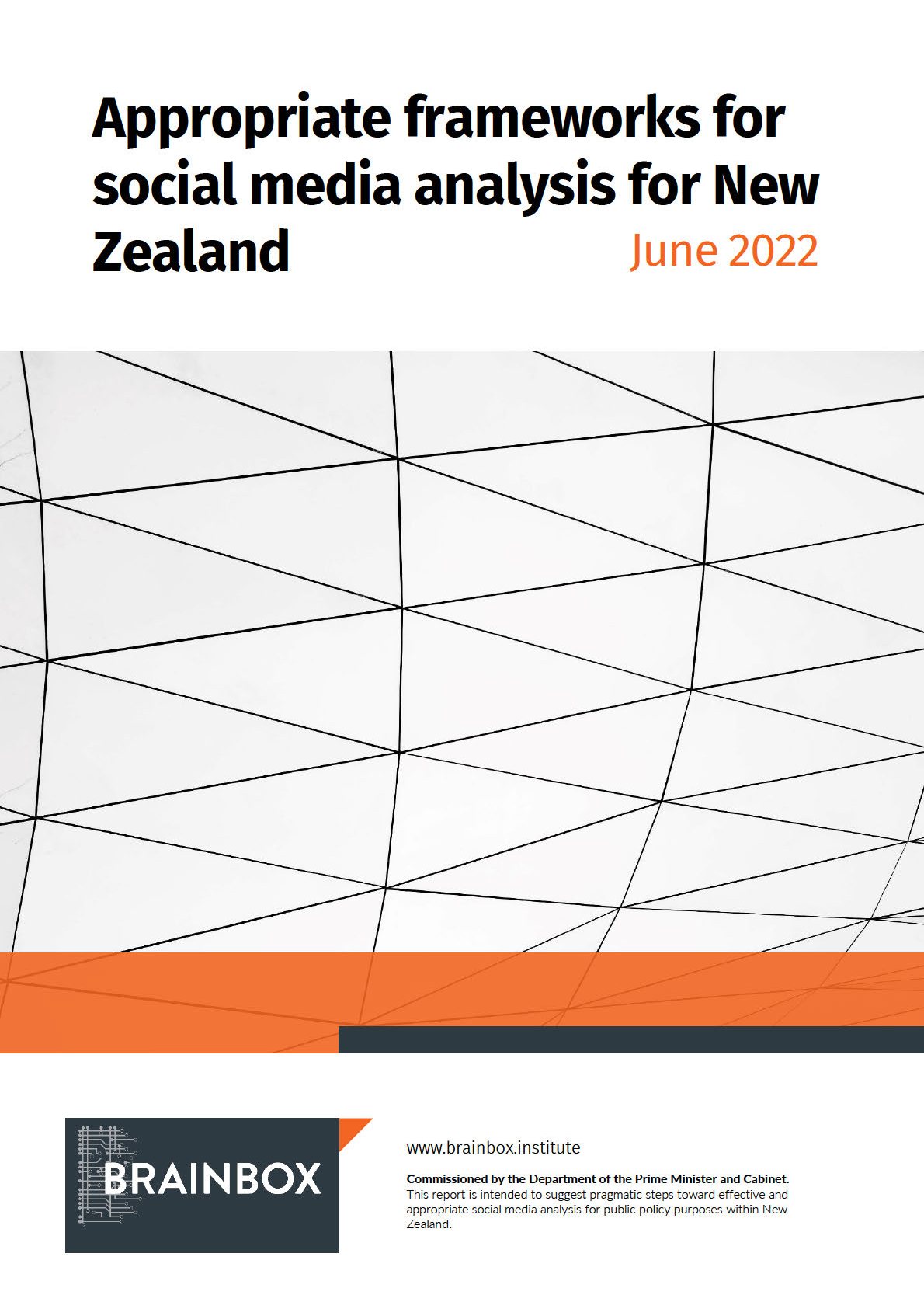
1982
Act
Information
Official
the
under
Released
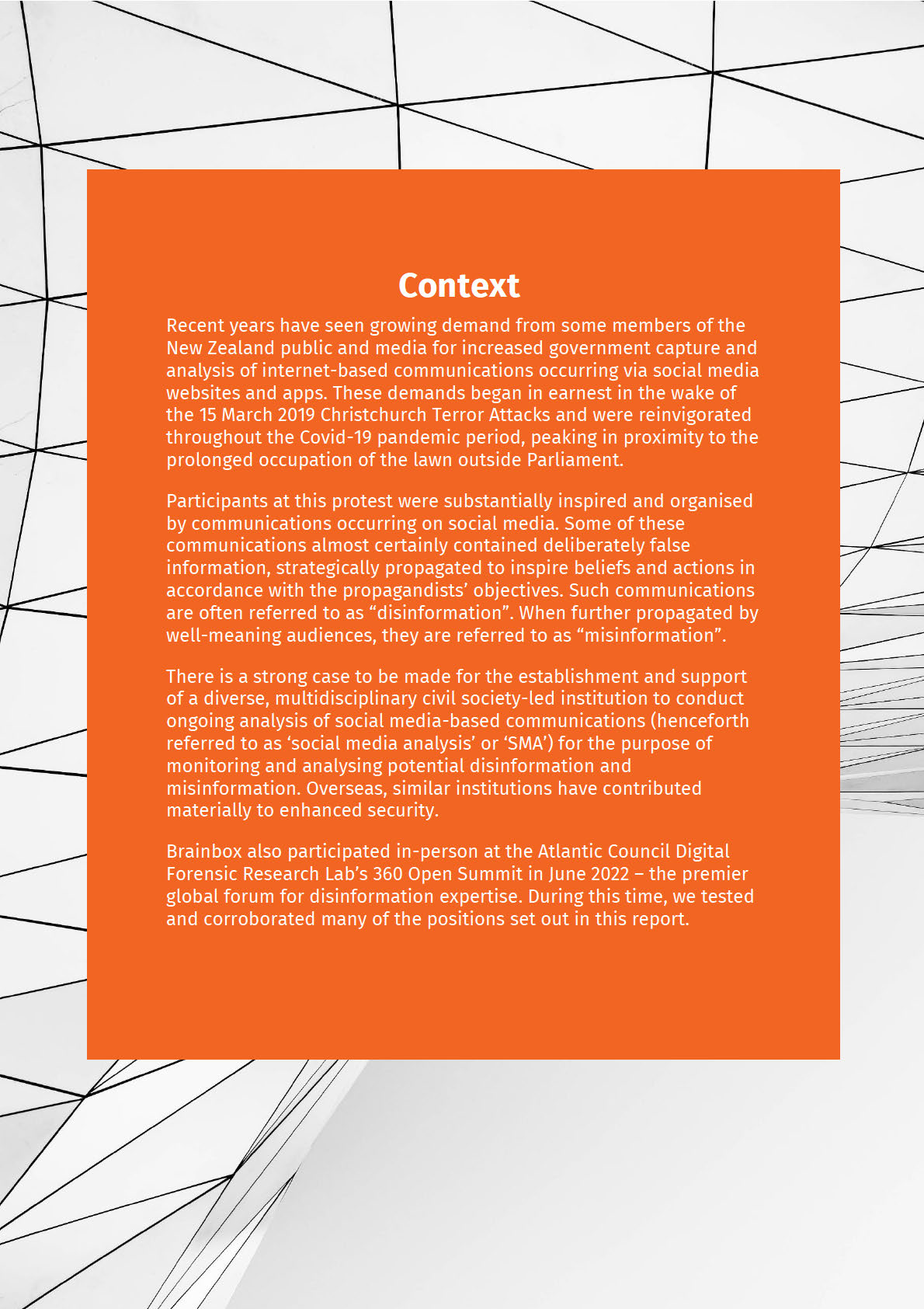
1982
Act
Information
Official
the
under
Released
CONTENTS
1982
Act
Executive Summary
1
Part I: Analysing social media disinformation
3
Why study manipulative communications?
3
The fundamentals of social media analysis
3
Part II: Limitations of the current landscape
4
Definitional difficulties
4
Barriers to accessing and processing relevant data
4
Overwhelming complexity
5
Information
Technological solutions are unreliable
5
SMA for situational awareness
5
Part III: Government-specific challenges
7
Legal and ethical constraints
7
Public perception Official
8
No path forward alone
8
Part IV: Growing Capacity outside government
9
the
The value of civil society groups
9
Why not simply support existing organisations?
9
Key design principles
10
Structure and functions
11
under
Annex A: Case studies
13
Annex B: Institutional considerations
16
Bibliography
18
Released
1982
Act
Information
Official
the
under
Released
Appropriate frameworks for social media analysis for New Zealand
Brainbox
1
• Accessing high quality data. Access to data is
Executive Summary
fraught, and even when large datasets can be
prepared, this data may be of poor quality for the
The case for systematic analysis and scrutiny of
purposes of the analysis. As a result, researchers
the communications exchanged on social media
are compelled to extrapolate from smal datasets or
(henceforth referred to as social media analysis or
study platforms and issues which facilitate easy
‘SMA’) is straightforward. In the best-case scenario,
access to data, whether or not they are the most
effective surveillance of social media
pressing subjects. Without prudence and integrity,
1982
this material y undermines the reliability of the
communications can produce useful insights
findings. This difficulty is exacerbated by the
about the extent to which disinformation is
growing number of communications across multiple
occurring. Equipped with these insights, different
online apps and websites.
Act
stakeholders across society can take effective
action to reduce the harms that disinformation
Government faces unique challenges
may cause.
There is no doubt that parts of the New Zealand
government, such as Police, already conduct SMA to
How this is carried out
some extent. In some cases, this is a necessary and
The fundamentals of SMA are simple. Data – primarily
useful part of the government carrying out its duties,
public communications made by users on social media
including to safeguard the rights of citizens. Outside law
platforms – is collected and then analysed. These
enforcement, a range of government agencies also use
communications are often text-based, and subsequently
off-the-shelf SMA products to monitor engagement
Information
can be analysed computationally in conventional ways,
with State communications on social media.
like keyword searching and the counting of visible
metrics of engagement by audiences.
Nevertheless, the government has obligations to act
legally and properly. These obligations create practical
Although facilitated by statistical programs and
barriers for government officials who wish to carry out
techniques, this kind of activity still requires extensive
effective capture and analysis of internet-based
Official
manual analysis and the exercise of significant human
communications. For example:
judgement. While there is a growing body of research
• The Terms of Service for most social media
that aims to develop automated techniques to detect or
platforms prohibit the large-scale ‘scraping’ of data
the
analyse disinformation without need for manual human
without their express oversight and permission.
intervention, such technologies remain unreliable.
Some jurisdictions have ruled that there are implicit
exceptions for non-commercial research, but the
Detection and analysis are hard
practice largely remains in a legal grey area. While
There are numerous difficulties inherent in detecting
more broadly accepted in academia, such
and analysing disinformation in social media-based
under
techniques are more controversial if undertaken by
communications. The two most significant are:
government researchers or contractors.
• Determining whether communications meet the
• Although it is true that disinformation occurs in
criteria of disinformation. Despite a consensus
publicly accessible social media-based
around a theoretical definition, many of the
communications, many of the most impactful
boundary criteria for that definition are difficult to
forums for disinformation are not publicly
objectively assess external y, such as the intention
accessible, e.g. closed Discord channels, WhatsApp
of the communicator. Others may be uncertain,
groups, Telegram channels, or private Facebook
such as the accuracy of the information. As a result,
groups. Gaining access to these requires that a
Released
determining whether a communication is
researcher behave deceptively. This bears
disinformation can be highly subjective – neutral
resemblance to orthodox espionage tradecraft. The
observers might disagree in good faith. Extrapolated
regulation of New Zealand government agencies
over enormous datasets, this undermines the
and public servants strictly controls the
reliability of findings.
circumstances and manner in which government
officials may conduct this kind of activity.
2
Appropriate frameworks for social media analysis for New Zealand
Brainbox
But even if government SMA is scrupulously legal and
•
Full integration into civil society, bringing
ethical, it will unavoidably attract negative public
together a wide range of participants.
attention due to a host of anxieties around privacy, free
•
Data access as a priority, taking advantage of
expression, and government influence over public
every source and platform.
discourse. While the extent of this backlash can be
•
Cross-platform focus, studying a range of
mitigated to some degree by keeping SMA limited in
platforms and the interactions between them.
scope and fully transparent, it is fundamental y
1982
unpredictable and runs the risk of undermining trust in
•
Continual self-assessment and development,
improving its capabilities and tools in response to
government, further radicalising at-risk users, driving
new requirements and research.
away potentially useful partner organisations, and
Act
delegitimising future efforts to combat disinformation.
•
Explicability at all stages, making sure that both
final outputs and analytical processes are
Towards a hybrid governance model
accessible and understandable.
Acting on its own, there is no viable way for the New
•
Insight from all sources, bringing together useful
Zealand government to access the benefits of SMA for
frameworks and information from SMA, sociology,
disinformation monitoring and mitigation. Rather, a non-
psychology, and community representatives.
government entity with appropriate governance
•
Te Ao Māori centrality, ensuring Te Tiriti
structures and funding security is the best vehicle for
obligations are met and mātauranga Māori is
this. This entity can formally or informal y incorporate a
respected.
multistakeholder arrangement, with stakeholders
Information
potentially including civil society, academia, industry,
New Zealand has the opportunity to learn from
and government itself. In addition to acting as a
overseas successes. It can model best practices in
mechanism for balancing the many important rights and
addressing these important and highly charged issues in
concerns inherent in this undertaking, a civil society
a way that is responsible, rigorous, and ful y engaged
group is likely to be a more appealing partner for social
with academia, civil society, Māori perspectives, and
media platforms and other entities that are reluctant to
the broader public.
Official
directly collaborate with state governments.
Non-government organisations in other jurisdictions
the
have produced world-leading research, conducted
crucial outreach efforts, and provided valuable insights
and advice to lawmakers. And New Zealand has a
number of unique features – among them mātauranga
Māori, Te Tiriti obligations, a comparatively high level of
under
social cohesion and media trust, its geopolitical location
in the Indo-Pacific, and a highly specific socioeconomic
milieu – that provide compelling reasons for
undertaking New Zealand-based work rather than
importing experts and conclusions from other
jurisdictions.
Drawing on a report on a similar topic by the Institute
Released
for Strategic Dialogue (ISD), Brainbox proposes the
following design principles to ensure that this civil
society group is able to maintain public credibility,
analytical rigour, and policy relevance:
Appropriate frameworks for social media analysis for New Zealand
Brainbox
3
Part I: Analysing social media disinformation
Why study manipulative
communications?
Although the role of the internet and technological
• Data gathered typically consists of publicly
architectures has recently reinvigorated public and
available communications posted by social
1982
political interest in such matters, social media is only the
media users; both their content and what is
latest theatre for propaganda. Disinformation is a subset
cal ed ‘metadata’: information about the
of propaganda, which has been studied deliberately
communications such as time posted, number
since at least the 1920s. Research from this period gave
of “likes”, “shares”, “retweets”, and
Act
rise to the field of behavioural psychology that forms
“impressions”.
the foundation of modern marketing. Since then,
• Some researchers may attempt to gain access
propaganda (and thus disinformation) has been a
to non-public spaces, such as closed Telegram
persistent feature in statecraft, warfare, politics, and
channels and private Facebook groups, in order
business – even if public interest in the subject has
to collect data on the communications therein.
ebbed and flowed.
This often entails some level of deceptive
behaviour. There are also recent examples of
Nevertheless, the internet and social media have
the use of likely unlawful techniques by actors
revolutionised traditional influence practices. They have
with pro-social intent to access and disclose
enabled asymmetrical propaganda activities to be
information that exposes harmful behaviour, for
carried out on a global scale at much less cost, with little
example among white supremacist groups.
Information
regard for time, distance, or local laws. Most people now
recognise that online manipulation has been leveraged
to affect societies in almost every material way: politics,
Data Analysis
beliefs, values, identities, purchasing habits, and more.
• Researchers scrutinise the data to develop
inferences about what it says and how it can be
Consequently, social media-based communications are
leveraged. Some level of manual analysis is
now routinely and systematically analysed by
almost always necessary, if only to verify and
Official
researchers across academia, business, and civil society.
legitimate the outputs of automated analysis
Much of this research focuses exclusively on
systems.
disinformation and its effects. Some government
agencies (e.g. Police) also conduct SMA to some degree.
• These automated systems are typically
the
designed to parse text and extract insights. This
can be as simple as searching for key words in
The fundamentals of social media
communications, or as complex as estimating
analysis
the ‘sentiment’ of social media posts associated
with certain topics. The more complex the
The fundamentals of SMA resemble other conventional
analysis, the greater the risk that automated
under
areas that make use of internet data – particularly
systems can mislead – either through biased
marketing and advertising, both commercial and
construction, or failure to capture
political. Data is first collected and then analysed.
communications’ full context.
Data Capture & Collection
• Researchers often map networks of user-
• Researchers gather whatever data they can
accounts that are publicly communicating with
access. With enough money, licences to access
each other or sharing the same content. This
large commercial datasets can be purchased
can identify the most prolific communicators,
from third-party data brokers, or from social
and to some degree the most influential
media platforms themselves. For more targeted
accounts. It can also give some indication of
Released
or low-budget research, data can be collected
whether communications are gaining traction
(often skirting the terms of service) directly from
with new audiences. This mapping exercise can
websites and apps. There is growing momentum
be confounded if activity is occurring across
toward researchers open sourcing their
multiple platforms and websites, where
computer programs for conducting this kind of
researcher access is limited only to particular
analysis in order to build civil society capacity
platforms.
and avoid duplication of resources.
4
Appropriate frameworks for social media analysis for New Zealand
Brainbox
Part II: Limitations of the current landscape
Current research into social media disinformation
• Finally, even if a satisfactory in-practice
is neither fully comprehensive nor conclusive,
definition of disinformation can be developed, it
is very difficult to develop automated systems
primarily due to three fundamental obstacles to
that can consistently apply it – a necessity,
effective SMA:
Definitional difficulties, barriers
given the vast quantities of data that must be
1982
to accessing or processing relevant data, and
processed.
the
overwhelming complexity of the systems
Barriers to accessing/processing
and influences in question.
Act
relevant data
• Limited access to data constrains the quality of
Definitional difficulties
research. While al science encounters this
Disinformation has various theoretical definitions in
problem, the study of internet communications
academic and policy contexts. It is general y regarded as
is particularly frustrated by the fact that there is
being false information created or distributed
an essentially limitless quantity of data in the
intentional y, sometimes with intent to cause harm. Each
hands of private companies which researchers
cannot easily gain access to.
of these criteria creates practical difficulties:
• Terms of Service for platforms, which usually
•
Intent: Unless it is explicitly stated, intent must
constrain wholesale extraction of data, can lead
be inferred from context. Factors such as
Information
researchers without a relationship with the
complexity, anonymity, cultural variance, and
platform to either limit sample sizes or skirt the
deliberate obfuscation make these inferences
TOS.
chal enging. Accurately inferring intent is time
consuming, prone to bias, and sometimes
• This incentivises the study of data that is
impossible.
relatively easy to collect, like public posts on
large social media platforms. By contrast, many
•
Falsehood: Most definitions agree that
of the most egregious and impactful examples
Official
disinformation must be false. However, this
of disinformation likely occur on smaller and
criterion poses three challenges. Firstly, complex
less scrupulous websites, forums, image boards,
issues often cannot be reduced to a binary of
private groups, or general y places where data
true or false. Secondly, some claims are
the
on the communications taking place is far less
verifiably true (i.e., they are empirically observed
accessible.
facts), but presented in a skewed frame or
stripped of important context. Finally, many
• Automated tools for analysing audio-visual
statements that may reasonably be called
content are significantly less accurate than
disinformation are ambiguous, cloaked in irony,
those available for text. This can lead
or simply non-falsifiable. The concept of truth is
researchers to neglect this category of content,
under
also political y contested in various ways unique
which is thought to be a highly significant one
to New Zealand (for example, discussions
in the spreading of disinformation.
around mātauranga Māori).
• It is not uncommon for researchers to withhold
These difficulties lead to several issues which undermine
their methodologies or datasets in the interests
the quality of the analysis produced.
of safety and security. While this may be
justified in some cases, it prevents effective
• First, the application of the theoretical definition
scrutiny of their results or methods. This makes
around intent and truth is highly subjective,
it difficult to have high confidence in research
increasing the risk that researcher bias shapes
findings, to identify and learn from mistakes, or
Released
research findings.
to suggest improvements, which hampers
• Second, it leads to the adoption of proxies or
scientific progress.
working definitions that do not adequately
match the theoretical definition as previously
outlined, but rely on more easily observable
indicators. This means that headline findings
about “disinformation” can also be misleading.
Appropriate frameworks for social media analysis for New Zealand
Brainbox
5
• Additional y, the pace of current inquiry is not
margins of error even when deployed in carefully
conducive to peer review. There is genuine and
controlled lab environments.
justified urgency to try and produce results and
recommendations in time for them to be useful
While there will undoubtedly be some role for ML going
– e.g. before an election, or within the
forward, even its most advanced applications have
timeframes of a vaccination drive. However, this
significant limitations. Social media platforms have been
all but eliminates opportunity to replicate a
using ML to automate aspects of moderation for many
study within relevant timeframes, and many if
1982
not most studies on online disinformation have
years, with mixed results; while companies regularly
likely never been subjected to a single
release reports on the swathes of rule-breaking content
replication attempt.
removed by these systems, large volumes of
Act
misinformation on their services continue to escape
Overwhelming complexity
detection – even on topics which have seen great focus
• False claims and damaging narratives are spread
and intensive fact-checking efforts, such as Covid
between platforms by countless formal and
vaccines.
informal networks of users – rendering each
platform both its own environment and a node
Ultimately, there is currently no technological solution
in a vast, ever-shifting ‘information ecosystem’.
for SMA that ful y mitigates the need for significant
• Platforms are constantly developing. Users,
manual work by qualified personnel with adequate
moderation policies, Terms of Service, and even
comprehension of cultural factors among relevant
technological foundations can change rapidly,
communities.
making it more difficult to rely on past research
Information
or methods as a guide.
Common research techniques are not
• There are a huge number of vectors for false
information: user posts, ads, news articles,
suitable for high-tempo work
memes, livestreams, and many more. What
disinformation looks like in practice is different
In this assessment, we have been considering how
for each vector and platform, making it difficult
Official
governments might use SMA to inform operational
to study them al with one approach.
decisions and guide public messaging. It is therefore
• New platforms are constantly emerging (such as
important to emphasise that much of the best work
Yubo, the platform used by the recent Uvalde
the described in academic or NGO literature is performed
shooter), and their place in networks and
‘information ecosystems’ often takes time to
retrospectively. It requires significant resource
become apparent. New platforms also typical y
investments and may be poorly suited to real-time
have less developed transparency processes and
decision-making. By contrast, we identified one method
are thus more difficult to study than their more
for high-tempo SMA that, while potentially effective,
established counterparts.
raises significant risks for legality, proportionality, and
under
There are still numerous contemporary examples of
human rights protections.
useful open-source research on topics of online
disinformation. For a selection of case studies, see
A resource-efficient SMA model for
Annex A: Case Studies.
situational awareness
Studies consistently show that a minority of users are
Technological solutions are unreliable
responsible for most of the communications within any
We caution against enthusiasm towards advanced
social media group or community of interest, and this is
technological solutions for monitoring or moderating
Released
also true in disinformation contexts. While
online disinformation. Many researchers and companies
conspiratorial narratives are typically generated by a
claim to have developed machine learning (ML) systems
cyclic exchange between influencers and the wider
for the automated detection of ‘fake news’ or ‘deceptive
conspiracy community, influential framings and claims
content’, but in practice these systems tend to use
will typical y pass through these key actors.
extraordinarily blunt metrics and have unacceptably high
6
Appropriate frameworks for social media analysis for New Zealand
Brainbox
As a result, identifying and monitoring key ‘influencers’
in anti-vaccine and other conspiratorial communities in
New Zealand could theoretical y provide a tolerably
accurate and timely indication of the narratives being
discussed in and disseminated by these communities.
An initial expenditure of cash, time, and expertise would
be required to identify these key actors (in addition to
1982
those already identified by efforts to date, such as the
Parliament occupation’s so-cal ed ‘disinformation
dozen’), but subsequent monitoring would be relatively
low cost – likely requiring only a small number of
Act
personnel checking in at regular intervals to parse
chatter and record the emerging themes.
However, Brainbox recommends against this
approach for the following reasons:
• It is highly likely specifically monitoring
individuals would amount to domestic
surveillance. As such, it would need to be
Information
conducted pursuant to relevant legislative and
oversight frameworks.
• Even if lawful, such activities may nevertheless
be inconsistent with international human rights
norms and invite widespread condemnation,
Official
undermining New Zealand’s international
diplomatic position. It may be that the
Government wishes to make the case for
conducting such monitoring by agencies without
the
a law enforcement function, however it is
critical that agencies performing such
monitoring make that case directly, and do not
edge into unlawful or unjustified surveillance
under the guise of SMA.
under
• Many high impact disinformation influencers
raise themes around distrust of government,
allege enhanced and secret state surveillance,
and persecution of people based on expression
of minority viewpoints. If the government were
to engage in this kind of behaviour it would
undermine public trust and confidence in the
Released
government while enhancing the standing of
those “disinformation influencers” by providing
actual or perceived evidence for their claims.
Appropriate frameworks for social media
analysis for New Zealand
Brainbox
7
Part III: Government-specific challenges
The New Zealand government has limited funds,
• Monitoring of specific private individuals, as
outlined in “a resource-efficient model for
personnel, and expertise to dedicate to social
situational awareness” would almost certainly
media analysis. Leading SMA firms charge high
qualify as government surveil ance. For
prices for access to their expertise and systems,
government surveillance to take place on the basis
1982
of harmful speech, human rights law requires a
which may be difficult to justify given the
substantial and specific case to be made in support:
uncertainty of outcomes in this area.
what specific communication, what kind of harm,
Act
to whom or to what, of what degree, what is the
In addition, systematic government capture and
likelihood of harm, and even then, is the harm
tolerable in a free and democratic society?
analysis of internet communications would
arguably amount to unjustified government
• Many of the most impactful forums for
disinformation are not publicly accessible: e.g.
surveillance. This speaks to both of the two key
closed Discord channels, WhatsApp groups,
impediments to government carrying out the
Telegram channels, or private Facebook groups.
activities discussed so far:
Legal and ethical
Gaining access to these typical y requires that an
investigator behave deceptively, e.g. by assuming a
constraints, and
public perception. These
pseudonymous online identity. This bears
barriers favour growing national SMA capacities
resemblance to orthodox espionage tradecraft. The
Information
outside government.
regulation of New Zealand government agencies
and public servants strictly controls the
circumstances and manner in which government
Legal and ethical constraints
officials may conduct this kind of activity.
Public servants have extensive obligations that constrain
their behaviour, including but not limited to those
• The Terms of Service for most social media
described in the State Services Commission Model
platforms prohibit the large-scale ‘scraping’ of data
without their express oversight and permission.
Official
Standards, such as:
While some jurisdictions have ruled that there are
•
Propriety – requirements to act in the public
implicit exceptions for non-commercial research,
interest as public servants
the practice largely remains in a legal grey area.
the
Despite this, many researchers will scrape data to
•
Political neutrality – requirements to both be
prepare adequate datasets for study. While widely
and to appear political y neutral
accepted in academia, this would be a risky
practice for government researchers or
•
Lawfulness and proportionality – including
contractors.
rational connection to a legitimate purpose
under
• Mass data collection by researchers often entails
•
Privacy – requirements to maintain the
the advertent or inadvertent capture of personal y
anonymity of private citizens as much as
identifying information, including names, phone
possible
numbers, addresses, and details of users’ private
lives. While some level of automated obfuscation
•
Algorithmic accountability – including
of this information is standard in the field, this level
accountability for automated systems
is almost certainly insufficient to fully anonymise
those whose communications are collected and
•
Transparency – disclosing collection and use of
could open the government to legal challenges.
public information, compliance with Official
Released
• Disinformation actors – and those who knowingly
Information and Public Records legislation
or unknowingly spread their material – are often
These obligations create practical barriers for
aware of and actively work to mitigate efforts to
government officials or contractors who wish to carry
study and counter their efforts. The requirement
for openness and transparency in government
out effective capture and analysis of internet-based
activity are likely to be abused by these groups to
communications. For example:
develop techniques to frustrate government SMA.
8
Appropriate frameworks for social media analysis for New Zealand
Brainbox
Public perception
No path forward alone
Governments carrying out SMA will attract negative
Ultimately, there are no good options for the New
public attention, even if they do so lawfully and
Zealand government as a lone actor in this space. The
ethical y. The practice touches on a host of public
cutting edge of social media monitoring remains both
anxieties around privacy, free expression, and
time and resource intensive, and deeply imperfect.
government influence over public discourse. Any
Platforms are struggling to meet even the standards
1982
significant government investment in SMA will produce
they have set for themselves, despite access to al
narratives in the fol owing vein:
relevant data, ful knowledge of their own systems, and
access to leading experts. And government faces unique
•
Act
“The government is conducting surveillance
barriers to conducting effective social media analysis.
against its political opponents”
• “The label of “disinformation” is being used to
We also draw attention to the fact that recent reporting
silence legitimate debate”
by RNZ and the New Zealand Herald has disclosed
existing SMA efforts by DPMC which are expected to
• “Government and social media companies are
receive further investigation by the Office of the
working together to control public opinion”
Privacy Commissioner.
The traction and spread of these narratives can be
mitigated somewhat by limiting the scope and
Against this, we note the reality that:
enhancing the transparency of SMA efforts.
•
Information
Members of the public have already cal ed for
Nevertheless, the spread and influence of these
enhanced social media monitoring.
narratives will be difficult to predict and control, and will
• Agencies are already conducting some degree
depend heavily on reactions by opposition parties,
of monitoring, implying a perceived operational
media, and civil society groups. These narratives can
need for it.
have substantive impacts, including:
•
Undermining trust in government – both
• Public knowledge about the presence or
Official
policy and personnel
absence of monitoring activities can play a
deterrent effect toward external influence
•
Furthering radicalisation in fringe groups
operations.
that feel under threat
the
• The absence of monitoring may lead to
•
Driving audiences “off-platform” to harder-
to-access environments with more lax
unjustified assumptions that disinformation is
moderation and less visibility
occurring when it is not, undermining public
trust unnecessarily.
•
Legitimating more extreme monitoring
under
practices by other states
• New Zealand may not detect disinformation
activities which are occurring, meaning
•
Potential chilling of free speech as people
self-censor to avoid government observation –
influence operations are successful in ways
even those not taking part in mis- and
contrary to the public interest.
disinformation
Questions around digital disinformation are only going
•
Discouraging cooperation by useful partners,
to become more important, more complex, and more
such as diplomatic partners, domestic and
international civil society organisations and
controversial in the future, especially as legislation in
Released
social media platforms
the European Union, the United Kingdom and other
jurisdictions begins to be implemented. As a sovereign
•
Delegitimising future efforts to counter
nation committed to multilateralism, human rights and
disinformation or regulate social media
the rule of law, New Zealand must prepare for that
future in a way that amplifies our strengths and
mitigates our limitations.
Appropriate frameworks for social media
analysis for New Zealand
Brainbox
9
Part IV: Growing capacity outside government
Globally, there is a growing number of institutions, A civil society group is also likely to be a more appealing
partner for social media platforms and other entities
groups, and individuals outside government that
that are reluctant to directly collaborate with State
are engaged in regular open-source analysis of
governments and will al ow New Zealand to position
internet communications. Groups like the Institute
1982
itself more effectively to take advantage of emerging
for Strategic Dialogue, the Election Integrity
transparency regimes under legislative initiatives, which
Partnership, and InterAction have produced
grant greater data access to vetted researchers.
Act
world-leading research, conducted crucial
outreach efforts, and provided valuable insights
Why not simply support existing
and advice to lawmakers.
international organisations?
New Zealand has a number of unique features – among
Being wholly or partly outside of government
them a connection to mātauranga Māori, Te Tiriti
helps these practitioners to produce useful
obligations, comparatively high levels of social cohesion
analysis while maintaining public confidence.
and media trust, and a highly specific socioeconomic
milieu – that provide compelling reasons for
There is a strong case for supporting the
undertaking New Zealand-based work rather than
development of an institution or group of this kind
Information
importing experts and conclusions from other
for the benefit of New Zealand – modelled on the
jurisdictions. In addition, doing this work would grant
best global examples, but reflective of New
New Zealand greater credibility in international
Zealand’s unique cultural and legal characteristics. engagements on the issue, and allow us to give better,
Beyond this, there is an opportunity for a hybrid
more informed guidance to neighbours that may look to
New Zealand for support as access to social media
non-State regulatory mechanism that entrenches
Official
expands in the Pacific.
relevant relationships between civil society
groups, independent crown entities, and others.
New Zealand has the opportunity to model best
the practices in addressing this important and highly
The value of civil society groups
charged issue in a way that is responsible, rigorous, and
Even when the problem and its potential solutions are
ful y engaged with academia, civil society, indigenous
ful y understood, the fight against disinformation and
perspectives, and the broader public.
other social media harms will require a whole-of-society
approach. There must be broad buy-in to the path taken
Key design principles
under
– something which is unlikely if the work is perceived as
While there are many factors that influence the ultimate
a way for the government to exert influence over public
success of any civil society group, Brainbox believes
discourse. The meaningful incorporation of a diverse
that any decisions should be made with seven principles
array of voices on the issue will help counter fears of
in mind:
Full integration into civil society, data
government overreach, facilitate the inclusion of key
actors from the beginning of any further action, and
access as a priority, a cross-platform focus,
allow the balancing of the many important perspectives
continual self-assessment and development,
and stakes inherent in SMA such as privacy, commercial
explicability at all stages, insight from all sources,
Released
considerations, and Te Tiriti obligations.
and Te Ao Māori centrality. These are elucidated
overleaf and owe a deep debt to those expressed in the
ISD report “Developing a Civil Society Response to
Online Manipulation”.
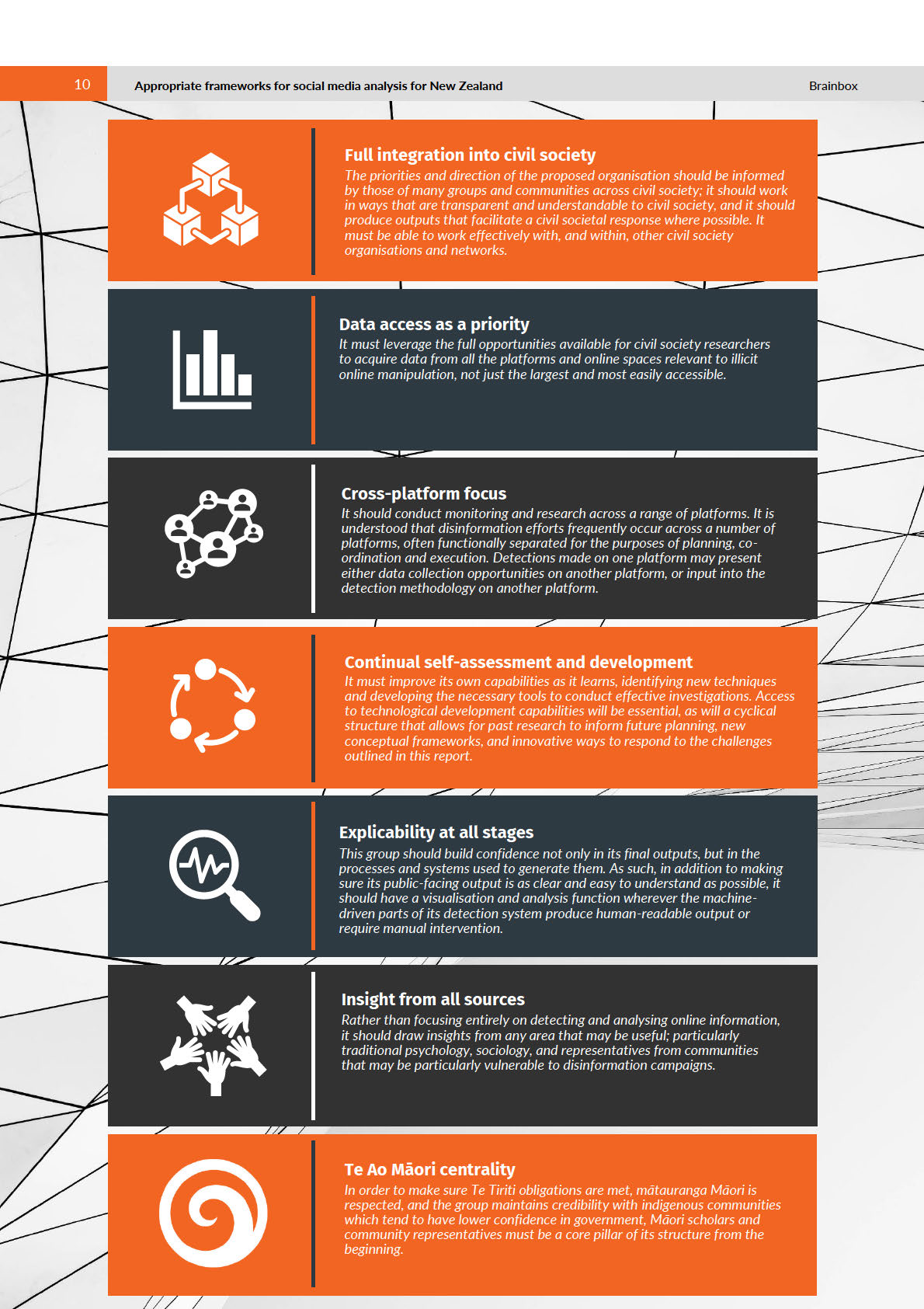
1982
Act
Information
Official
the
under
Released
Appropriate frameworks for social media analysis for New Zealand
Brainbox
11
Selecting and attracting the right personnel is also
Ful institutional design will take more detailed
crucial, and relationships with international practitioners
consultation. Regardless of the option chosen, we
should be encouraged. Our conversations with the
propose that the functions of any institution should
global multidisciplinary community in this area were
include the following:
encouraging, and we expect that a mixture of local and
•
Conduct empirical work: Fundamentally, the
overseas personnel is a realistic prospect. A prospective
institution’s mandate is to conduct empirical
civil society group focused on SMA must have access,
1982
work, using SMA techniques. This work must be
either through direct employment or wider networks, to
conducted in a way that al ows appropriate
the following expertise (drawing once again on ISD’s
scrutiny of its methods and techniques to build
report):
Act
reliable knowledge about the online
•
Data analysts and interrogators, who can
environment.
ensure the proper handling and analysis of data
•
Publish outputs for operational use: The
collected.
institution must publish its findings in relatable
•
Visualisation, technology and tool developers,
and meaningful ways targeted to specific
who can represent discoveries accessibly and
audiences. While there is some room for
construct technological tools that the group
theoretical or meta-level discussions on
needs.
relevant topics like definitions, outputs must be
tailored toward its primary function: conducting
•
Data journalists and subject matter experts,
SMA to build a meaningful picture of online
Information
who can understand and contextualise the
communications for use in operational
analytical outputs from the system and identify
environments.
the most promising leads for further
investigation.
•
Maintain actual and perceived independence
from government policy and influence: the
•
OSINT practitioners, who can conduct
institution should be tasked with actively
targeted investigations of the most harmful,
Official maintaining its perceived and actual
urgent and important detection that the system
independence from government policy.
has made.
•
Independent advocacy grounded in its
the
•
Legal experts in speech, platform law, and
empirical work: the institution must have an
Te Tiriti, who can ensure that work remains
advocacy and awareness-raising function. It will
justifiable and within legal boundaries.
be critical for the institution to have an
independent voice, particularly if it observes
behaviour by States which is contrary to the
Structure and functions
under
law or the public interest. Importantly, this
We suggest two models worth investigating as a non-
advocacy must be grounded in its empirical
State approach to SMA in a way that is consistent with
work in order to avoid straying into
New Zealand’s values:
substantively political disputes that compromise
its perceived independence.
1. Establish a civil society institution modelled on
•
Build broad global stakeholder relationships:
overseas institutions, such as DFR Lab or the
The institution ought to be tasked with building
Institute for Strategic Dialogue, which conducts
relationships with external institutions and
Released
SMA with a domestic focus at arm’s length from
research communities domestical y and
government aside from funding support.
internationally. This would include key
stakeholders such as governments, platforms,
2. Establish a hybrid governance institution with
community organisations, academia, and others.
an operational focus, that incorporates
participation by Government as a stakeholder,
alongside a range of other stakeholders that
could also include Independent Crown Entities.
12
Appropriate frameworks for social media analysis for New Zealand
Brainbox
•
Build capacity to conduct high quality empirical
way to ensure that the values of the Christchurch Cal
work: there are a range of training programmes
are embedded in the way we understand and respond
being run by civil society institutions that teach
to emerging online communication issues, while
people how to conduct safe, legal and ethical
protecting freedom of expression, privacy, and a
open source intelligence gathering and analysis.
plurality of voices in the public square.
The institution ought to play a role in building
capacity in New Zealand for conducting this
1982
kind of work, including by importing and
exporting personnel, and upskilling New
Zealanders with appropriate skill sets.
Act
•
Direct advisory and commissioned
investigations: As a body with scarce expertise,
the institution can provide direct advisory
services to government and non-government
actors. This could include being commissioned
to conduct specific pieces of work, as well as
using its expertise to tailor such work to reliable
and meaningful outputs.
Information
•
Explicit focus on human rights and a free and
open internet, and accounting for New
Zealand’s specific socio-political context: the
institution must be mandated to support,
promote and protect human rights and the
preservation of a free, open and interoperable
Official
global internet. It must also be tasked with
explicitly incorporating factors that make New
Zealand what it is, including our values, culture
and history.
the
Further considerations, such as recommended skills for a
prospective oversight board and relationship to existing
institutions, can be found in
Annex B: Institutional
Considerations.
under
Conclusion
SMA is already being undertaken by platforms,
advertisers, researchers, and parts of government.
However, as the field matures and states’ approaches
become more systematic, there is an absolute necessity
to ensure that future SMA work is responsible, reliable,
Released
and ethical.
New Zealand has become a leading voice on social
media issues in the wake of the Christchurch Cal , and
the approach we take to tackle disinformation will be
replicated around the world. This proposal lays out a
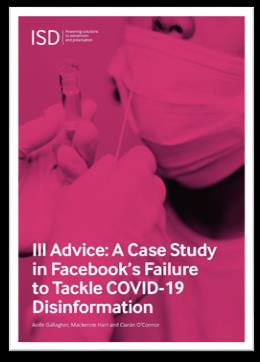 Appropriate frameworks for social media analysis for New Zealand
Brainbox
Appropriate frameworks for social media analysis for New Zealand
Brainbox
13
Annex A: Case Studies
E xample One: “Ill Advice: A Case Study in
Key findings:
• 78% of the group’s 1.2 million online followers
Facebook’s Failure to Tackle COVID-19
are found on mainstream platforms (Facebook,
Disinformation”
Instagram, YouTube, Twitter, TikTok) which
claim to prohibit vaccine misinformation. 1982
• Large proportions – often the majority – of the
most engaged-with content on Facebook
mentioning the World Doctors Al iance or its
Act
members in English, Spanish, German and
Arabic contained false, misleading or
conspiratorial claims related to COVID-19 and
vaccines.
• Organisations that are part of Facebook’s
factchecking program have debunked false
claims made by the World Doctors Alliance 189
times since the beginning of the pandemic.
Despite this extensive fact-checking effort,
Facebook has not taken decisive action on the
group or its members.
•
Information
ISD found minimal application of factchecking
labels across the four languages analysed, with
lower application rates on posts in German,
Spanish and Arabic than in English. Content
that does contain fact-checking labels was still
accumulating tens and sometimes hundreds of
thousands of engagements.
•
Official Facebook failed to track down and label all
versions of posts that have been deemed false
An ISD report on how effective Facebook (and to a
by fact-checkers, despite claiming that they
lesser extent other social media platforms) have been in
have AI technology that does this with a “very
tackling Covid misinformation, primarily through the lens
the
high degree of precision”.
of a case study of a group called the "World Doctors
• Members of the World Doctors Alliance
Alliance" (WDA).
produce content in huge quantities. Facebook’s
one-at-a-time approach to fact-checking
Their most crucial finding was that there's a lot of
presents a huge chal enge to fact-checkers and
content on Facebook nearly (or wholly) identical to
also al ows the purveyors of disinformation to
content that the platform has already taken down as
under
continue to spread false claims with little
misinformation. This indicates that Facebook's
pushback.
automated tools can't reliably identify content already
• When information that is true (e.g. hospitals
flagged by the company as false.
receive higher payments for COVID-19
patients) is used to spread a false narrative
The researchers used the CrowdTangle API to find
about the pandemic (e.g. case/death numbers
Facebook posts mentioning the WDA or its members,
are being manipulated), Facebook often does
then used an in-house data analytics tool to categorise
not label posts with additional context provided
them by language. They chose four languages to focus
by fact-checkers.
on (English, Spanish, German and Arabic), and then
Released
analysts manual y analysed the 50 most popular posts in
each language to determine whether they qualified as
“disinformation” and confirm whether any platform
action had been taken.

14
Appropriate frameworks for social media analysis for New Zealand
Brainbox
Example Two: “The Long Fuse:
Misinformation and the 2020 Election”
Key findings:
• While the EIP and other researchers predicted a
lot of the dynamics observed in practice, this
did not translate into being able to prevent or
combat them effectively.
• Lack of access to platform information made
the task of external workers and researchers
much harder.
•
1982
Non-falsifiable claims were a huge part of al
narratives and very chal enging for platforms.
• Framing was more impactful than individual
pieces of information.
Act
• There was a feedback loop between big media
figures and grassroots movement, each
generating narratives that would then be
amplified by the other.
• There were networks of overlapping groups
and audiences rapidly relaying pieces of
misinformation.
• Cross-platform spread was the norm, with
small, unregulated platforms like Parler
generating some of the worst content.
• Each platform served a different purpose in the
Information
misinformation 'ecosystem' – for example,
while Facebook was a place to reach large
audiences and organize action, Twitter was a
A report from the Election Integrity Partnership (EIP), a
place to mobilize and “eventize” longer-form
coalition of some of the foremost institutions in social
content stored elsewhere.
media research and policy (The Stanford Internet
• Moderation was consistently inconsistent and
Observatory, The University of Washington’s Centre for
lacked transparency, both hampering efforts to
an Informed Public, Graphika, and the Atlantic Council’s
Official push back and inflaming the conspiracists
Digital Forensic Research Lab) formed to combat voting
further.
related mis-and-disinformation in the 2020 US election
season. Despite world-class expertise, tangible support
On moderation, the report notes that bad actors
from government, links to platforms, and a focused
the adapted quickly to changes made to platform policy and
remit, the EIP arguably failed in its stated goal of
enforcement. Additionally, despite key “large spreader”
countering election-related misinformation in the US;
accounts consistently exhibiting behaviour that should
being unable to effectively combat widespread
(enforcing the spirit and letter of the platform policies)
narratives discrediting the election’s outcome, and
have gotten them banned, platforms typical y allowed
failing to anticipate or prevent the January 6th Capitol
them to remain up. This was sometimes justified with
under
riot.
"newsworthiness" exceptions, but was often not
justified at al .
The EIP had multiple tiers of on-cal analysts and
managers on shifts, taking in ‘tickets’: False or
The effects of "adding friction" to interactions with
misleading claims flagged by in-house monitoring or
posts flagged as misleading were inconclusive, as were
partners in government, Civil Society, platforms, and
the true effects of content labelling – which the report
news media. In total, they dealt with 639 "in-scope"
notes was inconsistently and often incorrectly applied.
tickets over the course of the project. The EIP relied
There were also significant differences in which content
primarily on external sources for fact-checking, and did
got labelled depending on the platform. There are four
not have a tasking relationship with these sources,
Released
problem areas that can't really be adequately addressed
limiting the scope they could cover.
by platform policy in EIP’s view: Cross-platform
complexities, the use of non-falsifiable content,
The EIP’s final report notes that their "per-ticket"
backlash against platform interventions, and organized
analysis made it more difficult to identify and analyse
outrage.
overarching narratives. This cataloguing of narratives
began only after the monitoring portion of their work
had completed, sorting individual tickets post hoc.
 Appropriate frameworks for social media
analysis for New Zealand
Brainbox
Appropriate frameworks for social media
analysis for New Zealand
Brainbox
15
Example Three: “(Mis)Information
Dissemination in WhatsApp: Gathering,
Analyzing and Countermeasures”
• Researchers were able to automate the process
of downloading images, reverse google
searching them, finding if they'd appeared on
fact checking sites, and extracting the sites’
verdict without direct human involvement.
While a clever solution, this system was capable
only of identifying images already addressed by
1982
fact checkers.
• These researchers have created "WhatsApp
monitor", which applies these sorts of
Act
techniques to a number of Brazilian and Indian
WhatsApp groups and is still in use by
researchers and reporters. This approach would
be very likely do draw controversy if taken by
the government.
Key findings:
• WhatsApp demonstrated similar network
effects to more traditional social media
platforms regarding the viral sharing and spread
of content, despite limits on group size, due to
Information
crossover members between groups.
• Researchers claimed that 30% of captured
images that were fact checked as
An academic paper studying the spread of
misinformation could not be traced to prior
misinformation on WhatsApp during the 2018 Brazilian
sources, suggesting they were first posted on
election and national truck drivers’ strike, producing
WhatsApp.
valuable insights into the app’s information flows.
• WhatsApp was a very effective propagator of
However, some of the techniques used arguably breach
Official content to other sites – average time for a
the platform’s TOS, or would otherwise likely not be
piece of content to be distributed beyond
viable for government work.
WhatsApp was around a week (less for
unambiguous misinformation).
the
Key methodological features:
• A minority of groups were responsible for
• Researchers joined WhatsApp groups they
spreading the bulk of misinformation identified.
found links to by searching Google and other
social media sites manually. They did not
proactively identify themselves as researchers.
• Though the groups were technically publicly
under
accessible, most members likely had a
reasonable expectation of privacy.
• They periodical y downloaded all information
from these groups and replaced telephone
numbers and user names with unique
identifiers. This anonymisation would not have
removed other identifying data and would
almost certainly not meet government privacy
standards.
•
Released
The downloading of data, and what researchers
did with it, arguably constitutes a breach of
WhatsApp's TOS. WhatsApp has not objected,
however.
16
Appropriate frameworks for social media analysis for New Zealand
Brainbox
Annex B: Institutional Consider
ations
Relationship to existing
• Violent extremism by definition involves the
adoption of violence as a legitimate political
institutions
tool. It therefore justifies enhanced levels of
There are some obvious institutions that may come to
state intervention, including the involvement of
mind as existing institutional homes for these kinds of
law enforcement and state surveillance. Linking
functions. We note some reservations about
the institution to this kind of use of state
incorporating these functions into these existing
power may compromise its perceived
1982
institutions.
independence, and enhance the perception
that it is a tool of state surveil ance and control.
Academia and tertiary education
Act
•
institutions
While there is some relationship suggested
between disinformation or conspiracy theory
Situating the institution within academia or an existing
content and violent extremism, in many cases
tertiary education institution initial y has some appeal.
mis- or disinformation will fal into a grey zone
In particular, such institutions perform empirical work
where the justification for both monitoring and
frequently in situations of legal or ethical risk, and they
intervention is much less clear cut. Put shortly,
are used to building connections across civil society.
communications monitored on the basis they
However, the following risks should be kept in mind:
are “disinformation” are much more likely to be
acceptable differences of political opinion with
• General y speaking, academia and research
a range of plausibly pro-social intent, whereas
institutions are not tasked with direct
that is seldom the case when it comes to
operational input. Their mandate is frequently
communications being considered on the basis
Information
to explore larger societal level issues which, in
that they may be linked to violent extremism.
this case, are already well covered and may
On that basis, tasking a single institution with
conflict with the institution’s operational focus.
both monitoring disinformation and preventing
violent extremism may lead to scope creep in a
• Importantly, the institution we are proposing
way that compromises the integrity of both
should itself be open to rigorous criticism given
programmes of work.
the nature of its activities and its functions,
Official
especially from academics and universities.
Key areas and skills for
There is a risk that situating the institution
within an existing University or other tertiary
institution
the
or research institution might, in substance or
Regardless of whether option 1 or option 2 is preferred,
perception, compromise the capacity of such
there should be an oversight board or committee for
institutions to act as critic and conscience in
the institution. The members of that board should have
relation to the institution’s functions.
demonstrable expertise in the fol owing subject areas,
noting that one member may be able to speak to
He Whenua Taurikura – Centre for
multiple subject areas. The areas include:
under
Countering Violent Extremism
•
We have considered whether this kind of function
Te Tiriti and the requirements of Treaty
partnership, including an understanding of New
could sit with the recently implemented Centre for
Zealand's colonial history
Countering Violent Extremism. In particular, there is at
least a plausible relationship between disinformation
•
and situations of radical violent extremism. In addition,
Human rights and the rights of vulnerable or
minority communities, including those
there are likely to be areas of overlap when it comes to
protected by the prohibited grounds of
individual or community propensity to be radicalised by
discrimination in the Human Rights Act 1993
online communications, and the emerging literature on
Released
the role of platforms and algorithmic systems in
•
contributing to this relationship. However, we have the
Parliamentary democracy, rule of law, and
constitutional government, with a specific
following reservations about adding this function to He
focus on legality and the legal system,
Whenua Taurikura, despite the high degree of potential
independent of any specific focus on platform
overlap in subject matter between disinformation and
regulation
countering violent extremism:
Appropriate frameworks for social media analysis for New Zealand
Brainbox
17
• Expertise on theoretical aspects of propaganda
In model 2, these areas could be covered by
and online information
membership from Independent Crown Entities (such as
the Human Rights Commission or the Office of the
• Expertise on empirical aspects of how
Privacy Commission), and one or two representatives of
communications impact human behaviour
an appropriate Crown Agency, such as DPMC, or the
Ministry of Health.
• Expertise on digital technologies and their use
for empirical purposes, including analysis of
large data sets, and analysis of OSINT
1982
• Connections to the international community,
including international NGOs and human rights
organisations
Act
• While it may be inappropriate for the
intelligence community to be directly
represented, it will be important that the
oversight board includes people with some
understanding of intel igence gathering and
national security frameworks, given the links
with these subjects
• Expertise in the platform companies and an
industry perspective
Information
• Operational expertise in managing the volume
and scale of complaints about online harms
• Expertise in Executive Government and the
ability to bring a perspective from the needs of
institutions like the Cabinet, as well as
Official
expertise in the operations and requirements of
the public service
• Expertise in health, including public health and
the
health systems, given the particular focus on
the potential harms of health-related
information
• Expertise in the non-governmental sector,
including in community groups with a
under
commitment to civil and human rights and
limiting government over-reach
• Expertise in areas like geopolitics, international
relations, diplomacy and international affairs
• Expertise in internet infrastructure and the
requirements of and threats to a free and open
internet
Released
• Experience and expertise in governance of
corporate entities, whether commercial or
governmental or otherwise
18
Appropriate frameworks for social media analysis for New Zealand
Brainbox
Bibliography
“Anti-Lockdown Activity: Germany Country Profile.” ISD. Accessed May 26, 2022. https://www.isdglobal.org/isd-
publications/anti-lockdown-activity-germany-country-profile/.
“Anti-Muslim Hate.” CCDH. Accessed April 29, 2022. https://www.counterhate.com/anti-muslim-hate.
Appelman, Naomi, Stephan Dreyer, Pranav Bidare, and Keno Potthast. “Truth, Intention and Harm: Conceptual
1982
Challenges for Disinformation-Targeted Governance.” Internet Policy Review. Accessed May 23, 2022.
https://policyreview.info/articles/news/truth-intention-and-harm-conceptual-chal enges-disinformation-targeted-
governance/1668.
Act
“Between Conspiracy and Extremism: A Long COVID Threat? An Introductory Paper.” ISD. Accessed May 26, 2022.
https://www.isdglobal.org/isd-publications/between-conspiracy-and-extremism-a-long-covid-threat-introductory-
paper/.
Bradford, Ben, Florian Grisel, Tracey Meares, Emily Owens, Baron Pineda, Jacob Shapiro, Tom Tyler, and Danieli
Peterman. “Report Of The Facebook Data Transparency Advisory Group.” Justice Col aboratory. Accessed June 9,
2022. https://www.justicehappenshere.yale.edu/reports/report-of-the-facebook-data-transparency-advisory-
group.
Burton, Jason W., Nicole Cruz, and Ulrike Hahn. “Reconsidering Evidence of Moral Contagion in Online Social
Information
Networks.” Nature Human Behaviour 5, no. 12 (December 2021): 1629–35. https://doi.org/10.1038/s41562-021-
01133-5.
Cameron, Dell, Shoshana Wodinsky, and Mack DeGuerin. “We’re Publishing the Facebook Papers. Here’s What
They Say About Donald Trump, the 2020 Election, and Jan. 6.” Gizmodo, April 18, 2022.
https://gizmodo.com/facebook-papers-donald-trump-2020-election-jan-6-capito-1848698220.
Official
Carl Miller [@carljackmiller]. “The World of Disinformation Response Is Growing Fast. Lots of New Commercial
Offerings. For Anyone Looking at These, There Are a Few Things to Avoid: - Any Detection Capability Predicated on
Some Secret, Proprietary, Universally-Applicable Algorithm. Full Stop. 1/.” Tweet. Twitter, April 21, 2022.
https://twitter.com/carljackmiller/status/1517082933047271424.
the
Claire Wardle, Hossein Derakhshan. “Information Disorder: Toward and Inderdisciplinary Framework for Research
and Policy Making,” 2017. https://rm.coe.int/information-disorder-report-version-august-2018/16808c9c77.
Clegg, Nick. “Combating COVID-19 Misinformation Across Our Apps.” Meta (blog), March 25, 2020.
https://about.fb.com/news/2020/03/combating-covid-19-misinformation/.
under
Clothier, Brent. “He Pānui Statement.” Royal Society Te Apārangi. Accessed May 23, 2022.
https://www.royalsociety.org.nz/news/he-panui-statement/.
Colliver, Chloe, and Carl Miller. “Developing a Civil Society Response to Online Manipulation.” ISD, n.d.
https://www.isdglobal.org/isd-publications/developing-a-civil-society-response-to-online-manipulation/.
Comerford, Milo, Jakob Guhl, and Carl Miller. “Understanding the New Zealand Online Extremist Ecosystem.” ISD,
n.d.
Released
“COVID-19 Misinformation - Twitter Report.” Twitter. Accessed June 9, 2022.
https://transparency.twitter.com/en/reports/covid19.html.
Deutsche Akademie Der Naturforscher Leopoldina, Deutsche Akademie Der Technikwissenschaften, and Union Der
Deutschen Akademien Der Wissenschaften. “Digitalisation and Democracy.” Series on Science-Based Policy Advice:
Position Paper. MyCoRe Community, 2021. https://doi.org/10.26164/LEOPOLDINA_03_00407.
Appropriate frameworks for social media
analysis for New Zealand
Brainbox
19
@DFRLab. “Polish-Language Telegram Channels Spread Anti-Refugee Narratives.” DFRLab (blog), May 31, 2022.
https://medium.com/dfrlab/polish-language-telegram-channels-spread-anti-refugee-narratives-aaf3ffdc81ed.
Wardle, Claire. “Information Disorder, Part 1: The Essential Glossary.” First Draft Footnotes, July 9, 2018.
https://medium.com/1st-draft/information-disorder-part-1-the-essential-glossary-19953c544fe3.
Dreyer, Stephan, Pranav Bidare, and Clara Keller. “Between Evidence and Policy: Bridging the Gap in Disinformation
Regulation.” Internet Policy Review. Accessed May 30, 2022. https://policyreview.info/articles/news/between-
1982
evidence-and-policy-bridging-gap-disinformation-regulation/1667.
Epstein, Ben. “Why It Is So Difficult to Regulate Disinformation Online.” In The Disinformation Age: Politics,
Act
Technology, and Disruptive Communication in the United States, edited by Steven Livingston and W. Lance
Bennett, 190–210. SSRC Anxieties of Democracy. Cambridge: Cambridge University Press, 2020.
https://doi.org/10.1017/9781108914628.008.
Farajtabar, Mehrdad, Jiachen Yang, Xiaojing Ye, Huan Xu, Rakshit Trivedi, Elias Khalil, Shuang Li, Le Song, and
Hongyuan Zha. “Fake News Mitigation via Point Process Based Intervention,” n.d., 10.
Fathaigh, Ronan Ó, Natali Helberger, and Naomi Appelman. “The Perils of Legal y Defining Disinformation.” Internet
Policy Review 10, no. 4 (November 4, 2021). https://policyreview.info/articles/analysis/perils-legally-defining-
disinformation.
Funke, Daniel, and Daniela Flamini. “A Guide to Anti-Misinformation Actions around the World.” Poynter (blog).
Information
Accessed May 30, 2022. https://www.poynter.org/ifcn/anti-misinformation-actions/.
Gal agher, Aoife, Mackenzie Hart, and Ciarán O’Connor. “Ill Advice: A Case Study in Facebook’s Failure to Tackle
COVID-19 Disinformation.” ISD, n.d.
Haidt, Jonathan, and Chris Bail. “Social Media and Political Dysfunction.” Google Docs. Accessed May 30, 2022.
https://docs.google.com/document/u/0/d/1vVAtMCQnz8WVxtSNQev_e1cGmY9rnY96ecYuAj6C548/edit?usp=e
Official
mbed_facebook.
Hall, Kristin. “Misinformation: Down the Rabbit Hole, and Back.” 1 News. Accessed May 26, 2022.
the
https://www.1news.co.nz/2022/04/04/misinformation-down-the-rabbit-hole-and-back/.
Hameleers, Michael, Edda Humprecht, Judith Möller, and Jula Lühring. “Degrees of Deception: The Effects of
Different Types of COVID-19 Misinformation and the Effectiveness of Corrective Information in Crisis Times.”
Information, Communication & Society 0, no. 0 (December 31, 2021): 1–17.
https://doi.org/10.1080/1369118X.2021.2021270.
under
Hannah, Kate, Sanjana Hattotuwa, and Kayli Taylor. “Working Paper: The Murmuration of Information Disorders,”
2022, 22.
Harvey, David. “Fear Itself?” The IT Countrey Justice (blog), May 20, 2022.
https://theitcountreyjustice.wordpress.com/2022/05/20/fear-itself/.
Global Witness. “How Facebook’s Algorithm Amplifies Climate Disinformation.” Accessed April 14, 2022.
https://www.globalwitness.org/en/campaigns/digital-threats/climate-divide-how-facebooks-algorithm-amplifies-
climate-disinformation/.
Released
“Information Operations - Twitter Report.” Twitter. Accessed June 9, 2022.
https://transparency.twitter.com/en/reports/information-operations.html.
Ingram, Matthew. “Facebook ‘Transparency Report’ Turns out to Be Anything But.” Columbia Journalism Review.
Accessed June 9, 2022. https://www.cjr.org/the_media_today/facebook-transparency-report-turns-out-to-be-
anything-but.php.
20
Appropriate frameworks for social media analysis for New Zealand
Brainbox
Atlantic Council. “Inside a New Effort to Define and Promote Tech Transparency,” December 14, 2021.
https://www.atlanticcouncil.org/news/transcripts/inside-a-new-effort-to-define-and-promote-tech-transparency/.
Jack, Caroline. “Lexicon of Lies.” Data & Society. Data & Society Research Institute, August 9, 2017.
https://datasociety.net/library/lexicon-of-lies/.
“January 2022 Coordinated Inauthentic Behavior Report.” Meta, February 16, 2022.
https://about.fb.com/news/2022/02/january-2022-coordinated-inauthentic-behavior-report/.
1982
Jungherr, Andreas, and Ralph Schroeder. “Disinformation and the Structural Transformations of the Public Arena:
Addressing the Actual Chal enges to Democracy.” Social Media + Society 7, no. 1 (January 1, 2021):
2056305121988928. https://doi.org/10.1177/2056305121988928.
Act
Keller, Clara Iglesias. “Don’t Shoot the Message: Regulating Disinformation Beyond Content.” Direito Público 18, no.
99 (October 28, 2021). https://doi.org/10.11117/rdp.v18i99.6057.
Keller, Daphne. “Some Humility About Transparency.” Accessed April 14, 2022.
https://cyberlaw.stanford.edu/blog/2021/03/some-humility-about-transparency.
Keller, Daphne, and Paddy Leerssen. “Facts and Where to Find Them: Empirical Research on Internet Platforms and
Content Moderation.” In Social Media and Democracy, edited by Nathaniel Persily and Joshua A. Tucker, 1st ed.,
220–51. Cambridge University Press, 2020. https://doi.org/10.1017/9781108890960.011.
Information
Lapowsky, Issie. “Why Facebook’s Data-Sharing Project Ballooned into a 2-Year Debacle.” Protocol, February 14,
2020. https://www.protocol.com/facebook-data-sharing-researchers.
Lewandowsky, Stephan, and Sander van der Linden. “Countering Misinformation and Fake News Through
Inoculation and Prebunking.” European Review of Social Psychology 32, no. 2 (July 3, 2021): 348–84.
https://doi.org/10.1080/10463283.2021.1876983.
Official
Lwin, May Oo, Jiahui Lu, Anita Sheldenkar, Peter Johannes Schulz, Wonsun Shin, Raj Gupta, and Yinping Yang.
“Global Sentiments Surrounding the COVID-19 Pandemic on Twitter: Analysis of Twitter Trends.” JMIR Public
Health and Surveillance 6, no. 2 (May 22, 2020): e19447. https://doi.org/10.2196/19447.
the
Lyons, Tessa. “Seeing the Truth.” Meta (blog), September 13, 2018. https://about.fb.com/news/2018/09/inside-
feed-tessa-lyons-photos-videos/.
MacCarthy, Mark. “Transparency Recommendations for Regulatory Regimes of Digital Platforms.” CIGI, 2022, 22.
Mcclain, Colleen, Regina Widjaya, Gonzalo Rivero, and Aaron Smith. “The Behaviors and Attitudes of U.S. Adults on
under
Twitter.” Pew Research Center: Internet, Science & Tech (blog), November 15, 2021.
https://www.pewresearch.org/internet/2021/11/15/the-behaviors-and-attitudes-of-u-s-adults-on-twitter/.
Michael Bang Petersen [@M_B_Petersen]. “Today, I Stood before the Danish Parliament on a Public Hearing on
Social Media & Democracy As a Researcher of Online Hate, I Could Have Spent Hours. But I Had 10 Minutes, so I
Had to Be Focused The Title Was ‘The Myths About Social Media’ Here Is What I Said👇 🧵(1/12).” Tweet.
Twitter, January 18, 2022. https://twitter.com/M_B_Petersen/status/1483457679800651787.
Miller, Carl, Jakob Guhl, and Milo Comerford. “ISD NZ Report: Methodological Discussion.” ISD, n.d.
Released
Mohan, Neal. “Inside Responsibility: What’s next on Our Misinfo Efforts.” blog.youtube. Accessed June 9, 2022.
https://blog.youtube/inside-youtube/inside-responsibility-whats-next-on-our-misinfo-efforts/.
Morgan, Kevin. “Taking Action against COVID-19 Vaccine Misinformation.” Newsroom | TikTok (blog), August 16,
2019. https://newsroom.tiktok.com/en-gb/taking-action-against-covid-19-vaccine-misinformation.
Appropriate frameworks for social media analysis for New Zealand
Brainbox
21
Nimmo, Ben. “The Breakout Scale: Measuring the Impact of Influence Operations.” Brookings Institute, n.d.
Nimmo, Ben, David Agranovich, and Nathaniel Gleicher. “Adversarial Threat Report #1 (Q1 2022).” eta, n.d.
O’Connor, Ciarán. “The Conspiracy Consortium: Examining Discussions of COVID-19 Among Right-Wing Extremist
Telegram Channels.” ISD, n.d.
Odabaş, Meltem. “10 Facts about Americans and Twitter.” Pew Research Center (blog). Accessed May 30, 2022.
1982
https://www.pewresearch.org/fact-tank/2022/05/05/10-facts-about-americans-and-twitter/.
OEDC Digital Economy Papers. “Transparency Reporting on Terrorist and Violent Extremist Content Online : An
Update on the Global Top 50 Content Sharing Services | En | OECD.” Accessed April 27, 2022.
Act
https://www.oecd.org/digital/transparency-reporting-on-terrorist-and-violent-extremist-content-online-8af4ab29-
en.htm.
Park, Sora, Kerry McCal um, Jee Young Lee, Kate Holland, Kieran McGuinness, Caroline Fisher, and Emma John.
“COVID-19: Australian News and Misinformation Longitudinal Study.” Report. News and Media Research Centre,
March 21, 2022. Australia. https://apo.org.au/node/316582.
Persily, Nathaniel, and Joshua A. Tucker, eds. Social Media and Democracy: The State of the Field, Prospects for
Reform. 1st ed. Cambridge University Press, 2020. https://doi.org/10.1017/9781108890960.
Pickles, Kristen, Erin Cvejic, Brooke Nickel, Tessa Copp, Carissa Bonner, Julie Leask, Julie Ayre, et al. “COVID-19
Information
Misinformation Trends in Australia: Prospective Longitudinal National Survey.” Journal of Medical Internet Research
23, no. 1 (January 7, 2021): e23805. https://doi.org/10.2196/23805.
“Platform Manipulation - Twitter Report.” Twitter. Accessed June 9, 2022.
https://transparency.twitter.com/en/reports/platform-manipulation.html.
Resende, Gustavo, Philipe Melo, Hugo Sousa, Johnnatan Messias, Marisa Vasconcelos, Jussara Almeida, and Fabrício
Official
Benevenuto. “(Mis)Information Dissemination in WhatsApp: Gathering, Analyzing and Countermeasures.” In The
World Wide Web Conference, 818–28. San Francisco CA USA: ACM, 2019.
https://doi.org/10.1145/3308558.3313688.
the
Rosen. “An Update on Our Work to Keep People Informed and Limit Misinformation About COVID-19.” Meta (blog),
April 16, 2020. https://about.fb.com/news/2020/04/covid-19-misinfo-update/.
Rossini, Patrícia, Jennifer Stromer-Galley, Erica Anita Baptista, and Vanessa Veiga de Oliveira. “Dysfunctional
Information Sharing on WhatsApp and Facebook: The Role of Political Talk, Cross-Cutting Exposure and Social
under
Corrections.” New Media & Society 23, no. 8 (August 1, 2021): 2430–51.
https://doi.org/10.1177/1461444820928059.
“Rules Enforcement - Twitter Report.” Twitter. Accessed June 9, 2022.
https://transparency.twitter.com/en/reports/rules-enforcement.html.
Sarang. “Community Standards Enforcement Report Assessment Results.” Meta (blog), May 17, 2022.
https://about.fb.com/news/2022/05/community-standards-enforcement-report-assessment-results/.
Schulz, Wolfgang, Stephan Dreyer, Elena Stanicu, and Keno Potthast. “Disinformation: Risks, Regulatory Gaps and
Released
Adequate Countermeasures. Expert Opinion Commissioned by the Landesanstalt Für Medien NRW.” Leibniz
Institute for Media Research | Hans-Bredow-Institut, November 10, 2021.
Scott, Hamilton. “As a Matter of Fact.” North & South Magazine, April 3, 2022.
https://northandsouth.co.nz/2022/04/03/richard-dawkins-matauranga-maori-debate/.
Shu, Kai, Amy Sliva, Suhang Wang, Jiliang Tang, and Huan Liu. “Fake News Detection on Social Media: A Data
Mining Perspective.” arXiv, September 2, 2017. http://arxiv.org/abs/1708.01967.

1982
Act
Information
Official
the
under
Released
Document Outline
































